Chang'e-5 (China's Lunar Sample Return Mission) / CE-5
Non-EO
CAST
Exploration
Quick facts
Overview
| Mission type | Non-EO |
| Agency | CAST |
| Launch date | 23 Nov 2020 |
Chang'e-5 (China's Lunar Sample Return Mission) / CE-5
Spacecraft Launch Mission Status References
Chang'e-5 is China's next step in its lunar program to pave the way to sample return missions to the Moon in late 2017. According to Chinese news services, the Chang'e-5 spacecraft (8.2 tons) is comprised of four parts: an orbiter, a lander, an ascender and a "returner" (an Earth reentry module). 1)
The mission will be China's first automated moon surface sampling probe. After touching down, the lander will place lunar samples into a vessel in the ascender. Then the ascender will take off from the lunar surface to dock with the orbiter and the returner, which will be circling the moon , and transfer the samples to the returner. The orbiter and returner then head back to Earth, separating from each other when they are several thousands kilometers from Earth. Finally, the returner will reenter the Earth. This scenario is provided by CASC (China Aerospace Science and Technology Corporation).
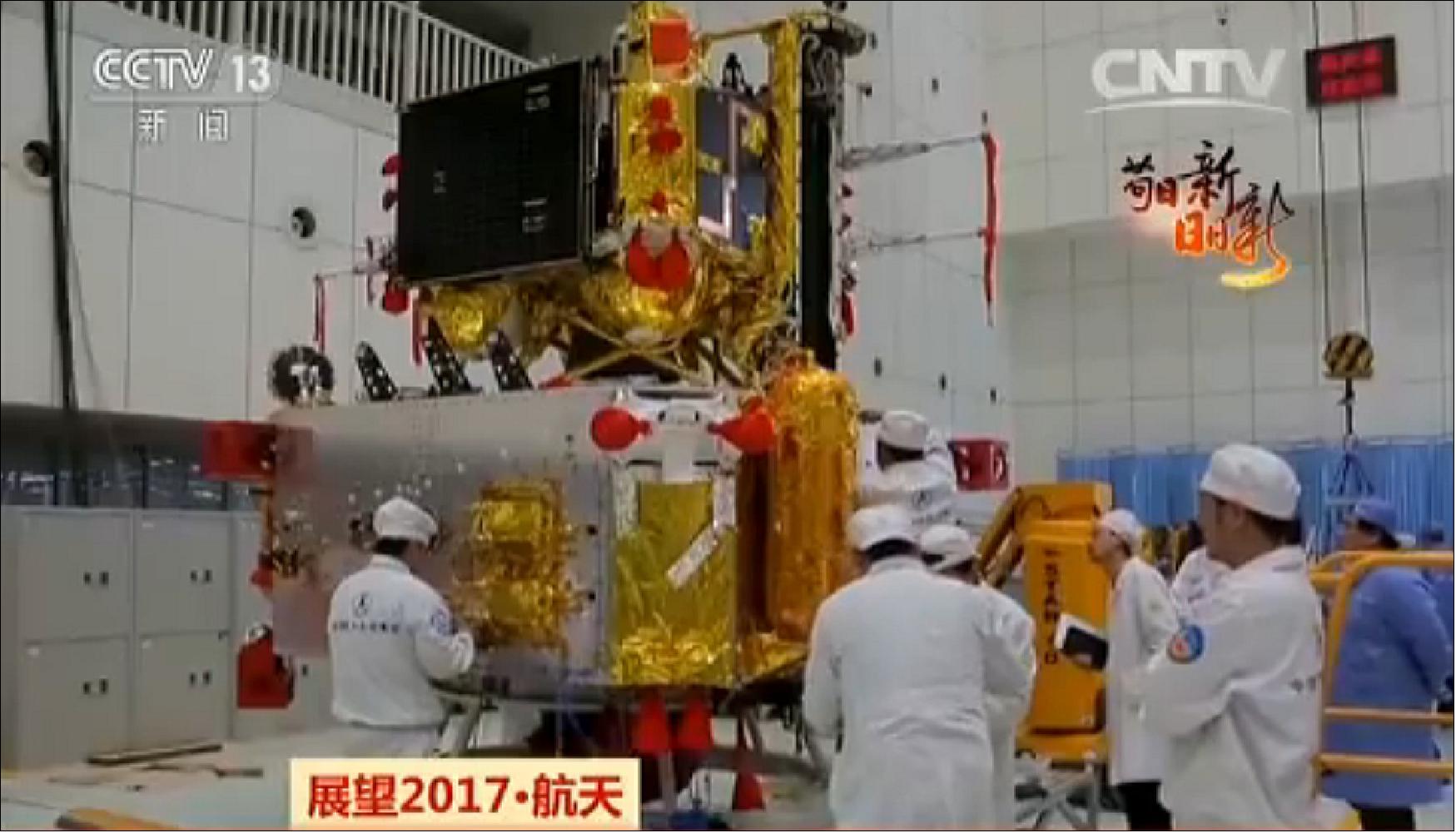
Chang’e-5 aims to collect and return around two kilograms of lunar samples and was earlier slated for launch before the end of 2020. Ship tracking and satellite data now indicate that China is readying for launch in late November. 2)
Specialized cargo ships Yuanwang-21 and -22 are understood to have collected Long March 5 components from the northern port city of Tianjin, the point of manufacture, and are currently transporting them to Qinglan, Hainan island. The components will then be delivered by road to Wenchang Satellite Launch Center.
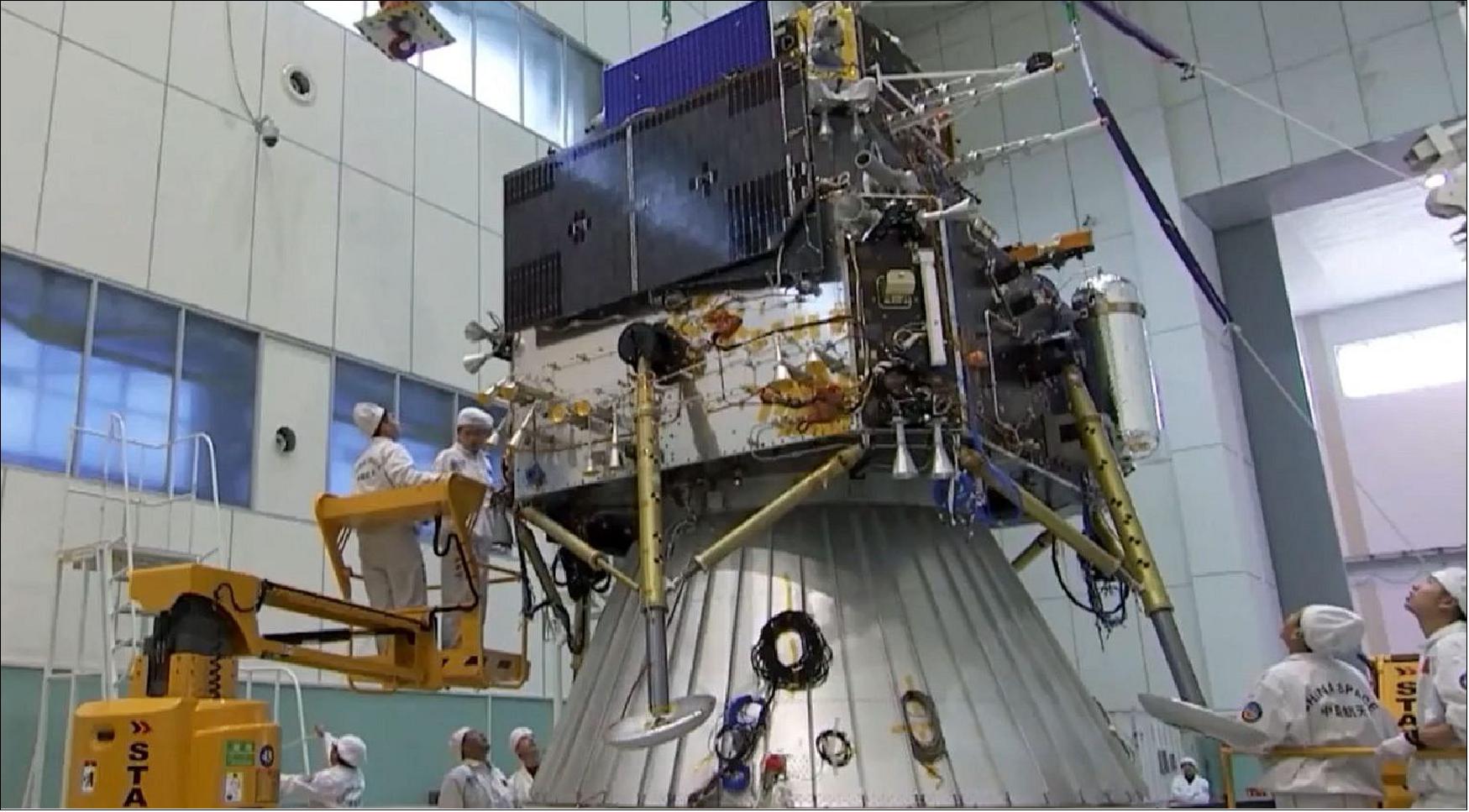
Chang’e-5 will target a site close to Mons Rümker, a volcanic formation situated in the Oceanus Procellarum region of western edge of the near side of the moon.
A late November launch would allow Chang’e-5 to enter lunar orbit close to sunrise over Mons Rümker, due to occur November 27, in preparation for landing.
Unlike China’s ongoing, multi-lunar-day Chang’e-4 spacecraft, the Chang’e-5 landing and sampling is expected to take place within a single, roughly 14-Earth-day lunar daytime.
Notably the Mons Rümker region contains geological units as young as around 1.21 billion years old. By comparison samples brought to Earth by Apollo astronauts are aged between 3.1 and 4.4 billion years old.
Future Plans
The complex mission involves four spacecraft, with a service module providing propulsion. Once on the moon, the mission lander will collect samples and place them in an ascent vehicle. This will liftoff and dock with the orbiting service module above the moon, using a robotic lunar orbit rendezvous rather than a direct return favored by Soviet Luna sample returns.
The samples will be transferred to a return module before leaving lunar orbit for Earth. The return module will detach from the service module on approach to Earth and then perform a ‘skip reentry’, bouncing off the upper atmosphere once to help deal with high velocity return from the moon. The 2014 Chang’e 5-T1 mission—a test for Chang’e-5—used a one-skip reentry.
The return capsule will deliver the samples to Siziwang Banner in Inner Mongolia. The same site is used for the country’s Shenzhou crewed mission landings.
The complexity of the mission profile is considered by observers to be related to future crewed lunar landing ambitions.
The mission is the third phase of the Chinese lunar exploration project formulated in the early 2000s. Orbiters Chang’e-1 and 2 and subsequent landing and roving missions Chang’e-3 and 4 marked the first two stages.
Chang’e-5 was originally scheduled for launch in late 2017. A Long March 5 failure in July that year delayed the mission and China’s space station project.
As with earlier phases the mission also has a backup, Chang’e-6. That mission will be repurposed for a sample return near the lunar south pole if Chang’e-5 proceeds according to plan.
China has stated it will then proceed into an extended phase of lunar exploration involving Chang’e-7 and further lunar landing missions. The aim will be to establish an ‘international lunar research station’ in the mid-to-late 2020s as a precursor to crewed landings.
Sample return technology and experience developed through Chang’e-5 is also to be utilized for planned near Earth asteroid and Mars sample return missions later in the decade.
Spacecraft
The Chang'e-5 spacecraft, desined and developed by CAST (Chinese Academy of Space Technology) consists of four modules which will go into lunar orbit - a Service Module, a Return Vehicle, the Lander and the Ascent Vehicle. Overall, the spacecraft will have a launch mass around about 8200 kg requiring a larger launch vehicle than previous missions. 3)
The Chang’e-5 Service Module includes all systems to support the assembled vehicle on the way to the Moon, remain in lunar orbit for an extended period of time while surface operations are in progress, rendezvous with the ascent vehicle in orbit and support the Return Vehicle during the transfer back to Earth, setting up for reentry.
The Service Module is equipped with power-generating solar arrays, communication systems for command uplink from Earth and telemetry downlink as well as a propulsion system and attitude control thrusters. Likely based on propulsion technology already used on Chang’e 3, the vehicle will use hypergolic propellants consumed by a throttable engine (likely the 7.5 kN engine used on Chang’e-3). The propulsion system of the Service Module would be used to conduct trajectory correction maneuvers on the way to the Moon, the lunar orbit insertion burn, orbital maintenance and the trans-Earth injection burn at the end of the mission.
The Service Module directly interfaces with the Return Vehicle that is installed in a cavity of the Service Module to reduce the overall length of the vehicle.
The Return Vehicle closely resembles the Shenzhou-capsule design in a scaled-down version. It is equipped with a modified heat shield to be able to withstand the re-entry into Earth’s atmosphere at speeds of 11 km/s. Landing is accomplished using parachutes that are deployed during atmospheric flight, starting with a drogue followed by the main Chute. The Return Vehicle includes a thruster system to actively control its orientation before re-entry and modify its reentry path by adjusting aerodynamic lift to target a reasonably sized landing zone. Onboard measurement systems and communication beacons for the location of the landed vehicle are also part of the entry vehicle.
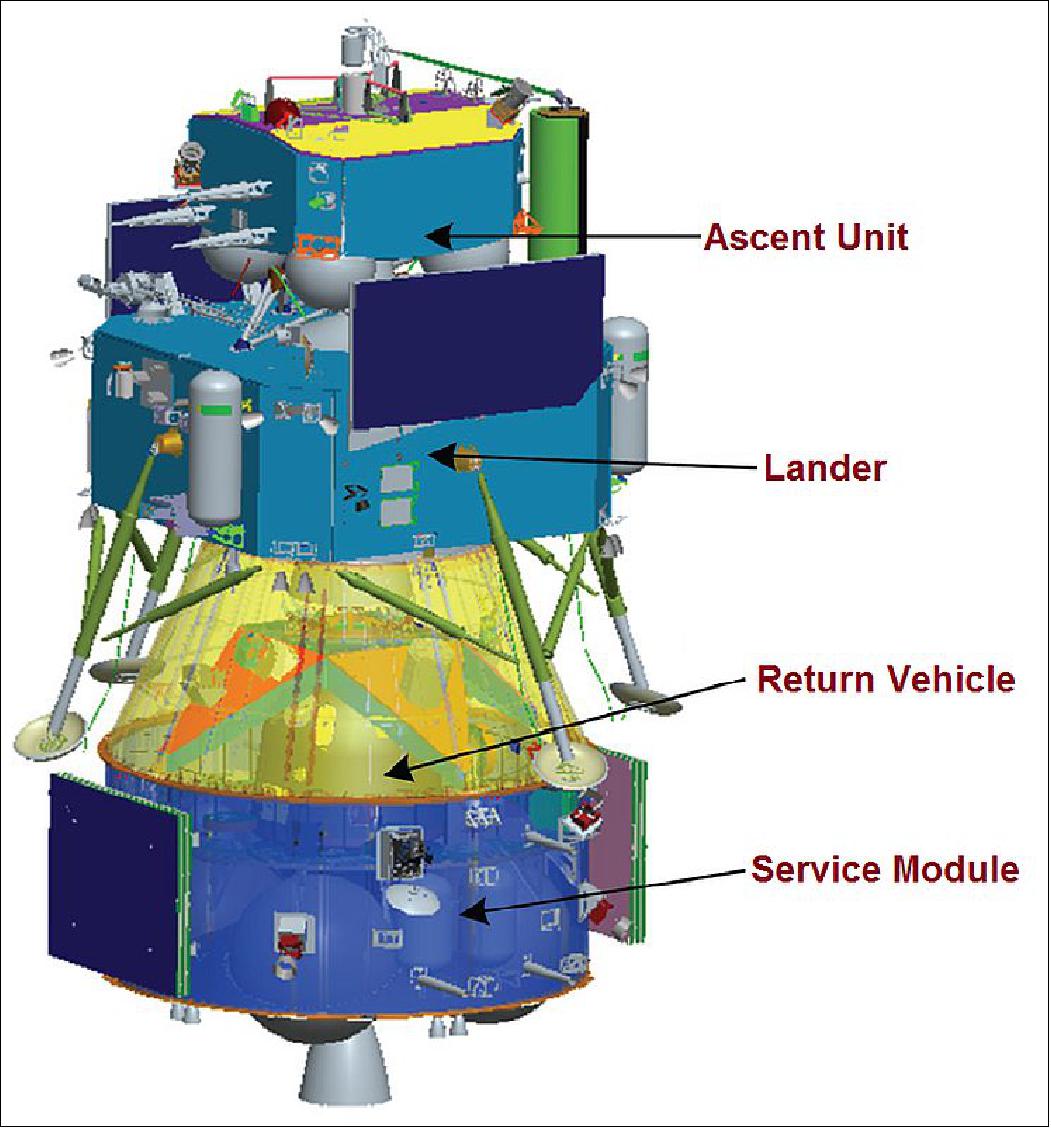
The Chang’e-5 lander in its structure is identical to the Chang’e-3 lander successfully demonstrated in 2013 with the obvious exception of ascent vehicle accommodations and surface sampling equipment that were not tested by Chang’e-3.
Lander: The lander has a dry mass of over one metric ton and a fueled mass of up to 3,800 kg. Four primary landing legs are installed on the lander using a cantilever-type design with bumpers and interior buffer elements in the primary struts and multi-functional secondary struts that interface with the bottom panel of the lander. The legs will have to create a sufficiently soft landing after the main engine is cut off around four meters above the lunar surface.
The propulsion system will also be similar to that used by Chang’e-3 consisting of a main engine that can be throttled from 1.5 to 7.5 kN to conduct a single continuous landing burn. Attitude control is provided by 28 thrusters providing thrust levels of 10 N and 150 N for three-axis control during orbital flight and the landing sequence. Power is delivered by two solar arrays that can be opened and closed on command. Navigation will be provided by an inertial guidance platform, a laser ranging system, an altimeter and an optical descent camera.
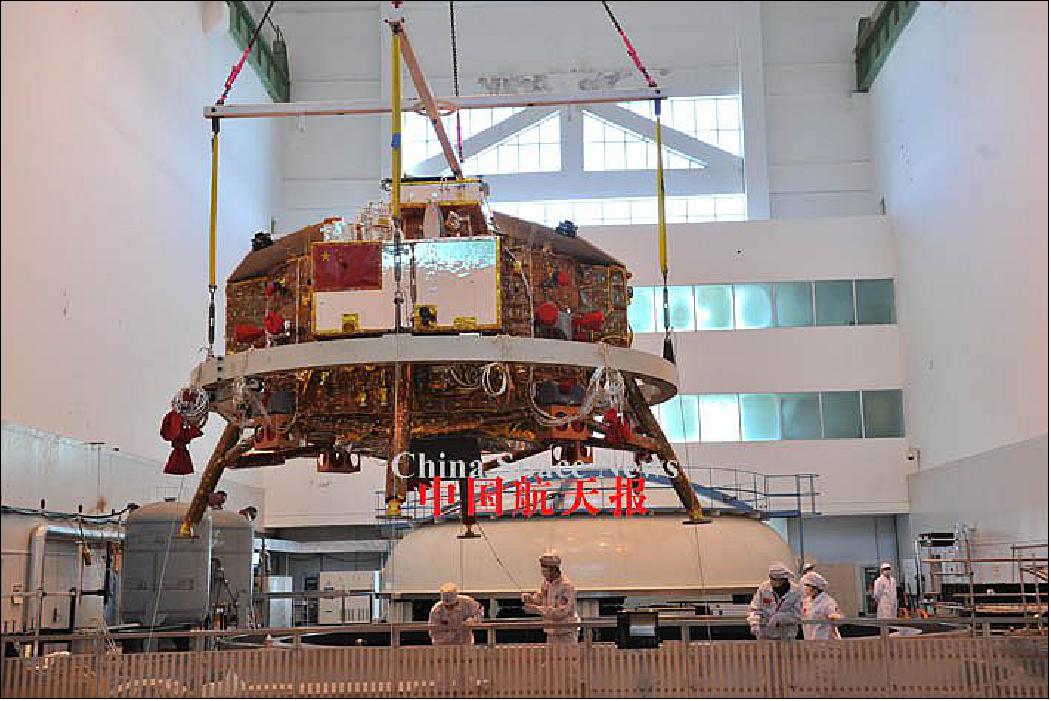
The Ascent vehicle resides on the top deck of the lander using structural attachments to remain in place during orbital flight, landing and the surface mission. A central interface from the lander to the Ascent vehicle is attached at the top of the vehicle using an arm that can be moved to the side to clear the way for the vehicle to launch from the top deck of the lander.
This interface includes electrical and data interfaces since the Ascent vehicle will leave its two solar panels in a stowed configuration for the flight to the Moon and the surface mission. The interface also facilitates the sample transfer mechanism.
According to information published in Chinese papers, Chang’e-5 will use a four-degree of freedom robotic arm for the acquisition of regolith samples and small rocks that are delivered to the Ascent Unit by the robotic arm. The end effector of the arm includes a scoop for the acquisition of samples, a sample processing system using vibration and separation mechanisms that ensure that several individual samples can be acquired without coming in contact with each other. The entire End Effector containing the samples can be separated from the arm for the transfer to the Ascent vehicle.
Additionally, the lander includes a coring drill and penetrating mechanism that will acquire one or more drill samples in the form of an intact core up to a depth of two meters making use of a rotary-percussive drilling mechanism. The drill core is delivered to the Ascent vehicle inside a Kevlar tube that provides sufficient stability to protect the core while being flexible enough to be compacted in size for transfer to the Ascent vehicle.
The Ascent Unit includes a main propulsion system built around a central main engine that is fired to lift off from the lunar surface, carrying the samples back into lunar orbit to link up with the Service Module – Return vehicle stack using rendezvous sensors developed for the Shenzhou spacecraft including laser ranging and optical sensors.
The docking is accomplished using a claw-type docking mechanism. On the active side, three claws (spaced 120°) close when coming into contact with the passive side of the system that includes struts to be grasped by the claws to create a firm bond between the Ascent Unit and the Return Vehicle. The samples are then transferred to the Return Vehicle using a robotic system of currently unknown specifications.
After sample transfers are complete, the Ascent Unit is separated so that the Service Module can boost the vehicle out of orbit and carry the Return Vehicle back to Earth.
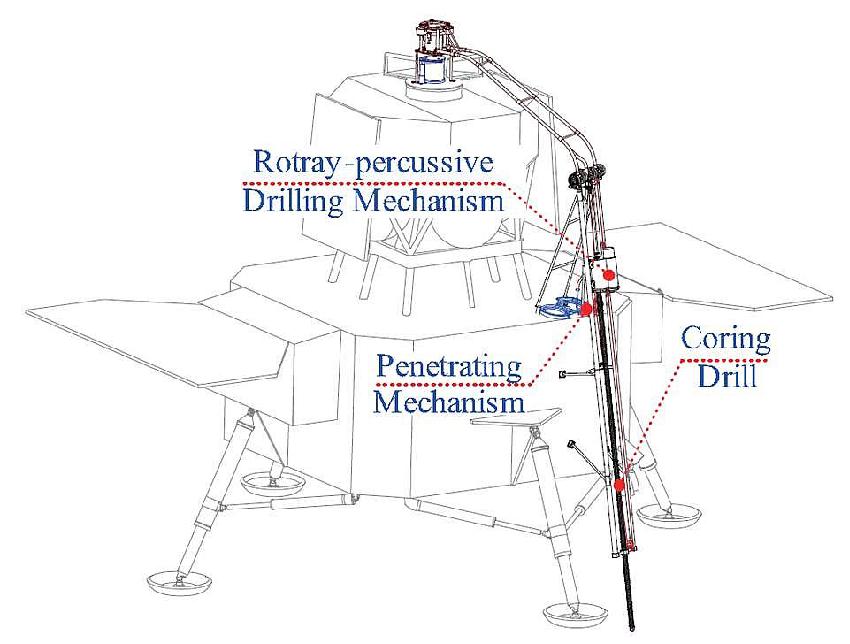
Payloads
Chang'e-5 carries landing cameras, a PCAM (Panoramic Camera),the LRPR (Lunar Regolith Penetrating Radar), and a visible and near-infrared Lunar Mineralogical Spectrometer (LMS).

Development Status
• November 20, 2020: China's second-generation space tracking ship Yuanwang 3 left here Thursday for missions concerning the Chang'e-5 lunar probe, according to sources with the country's satellite maritime tracking and controlling department. 5)
- China's Chang'e 5 mission, which is scheduled to be launched late this month, will bring moon samples back to Earth, making it one of the country's most complicated and challenging space explorations.
- Yuanwang 3 mainly undertakes maritime tracking and monitoring tasks of high-, medium- and low-orbit satellites, spacecraft and space stations.
- Since it was launched more than 20 years ago, the ship has made more than 50 voyages and completed 89 missions on the sea, including tracking of the Shenzhou spacecraft, the Chang'e lunar probe and BeiDou satellites, maintaining a 100 percent success rate.

- Two other tracking ships, Yuanwang 5 and Yuanwang 6, have also sailed out for their missions. The departures of these ships indicate that the Yuanwang fleet's maritime missions this year are coming to a close.
- Since the beginning of 2020, vessels of the Yuanwang fleet, sailing over 150,000 nautical miles, have performed monitoring missions of the last BeiDou satellite and China's first Mars probe, as well as transporting missions of the Long March carrier rockets.
• November 18, 2020: On 23 November, ESA’s Kourou station, located in French Guiana, will track the Chinese lunar mission, Chang’e-5, for several hours shortly after it launches. During this early phase, it is important to determine exactly where the spacecraft is in order to establish a communication link and verify the health of the newly launched craft. Kourou station will provide a way for the Chinese mission control team at the Beijing Aerospace Control Centre to acquire data from the spacecraft and confirm the status of the mission and its orbit. 6)
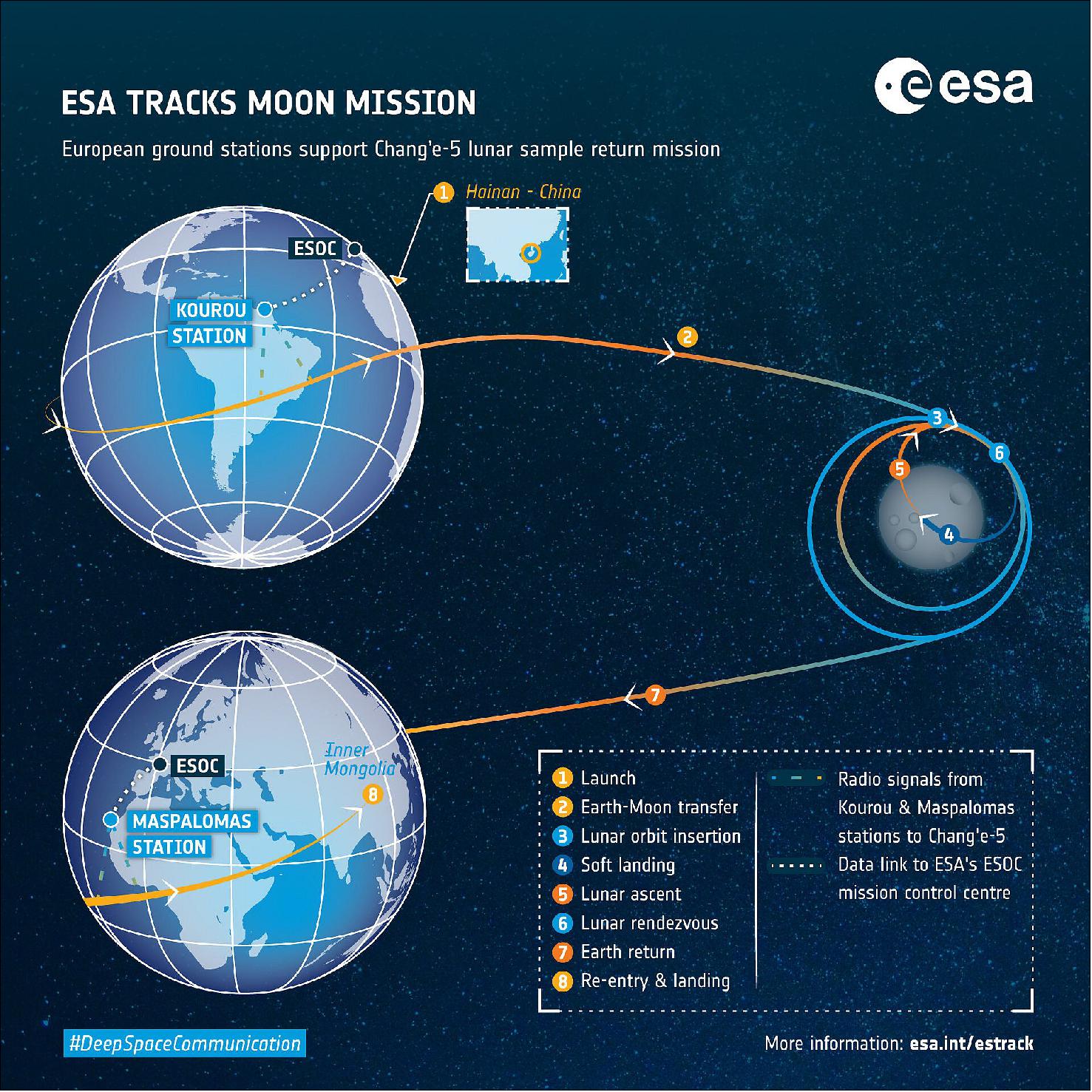
• November 17, 2020: The rocket to lift Chang'e-5, the latest mission in China's lunar exploration program, was moved to its launch pad in the Wenchang Space Launch Center in Hainan province on Tuesday morning, according to the China National Space Administration. 7)
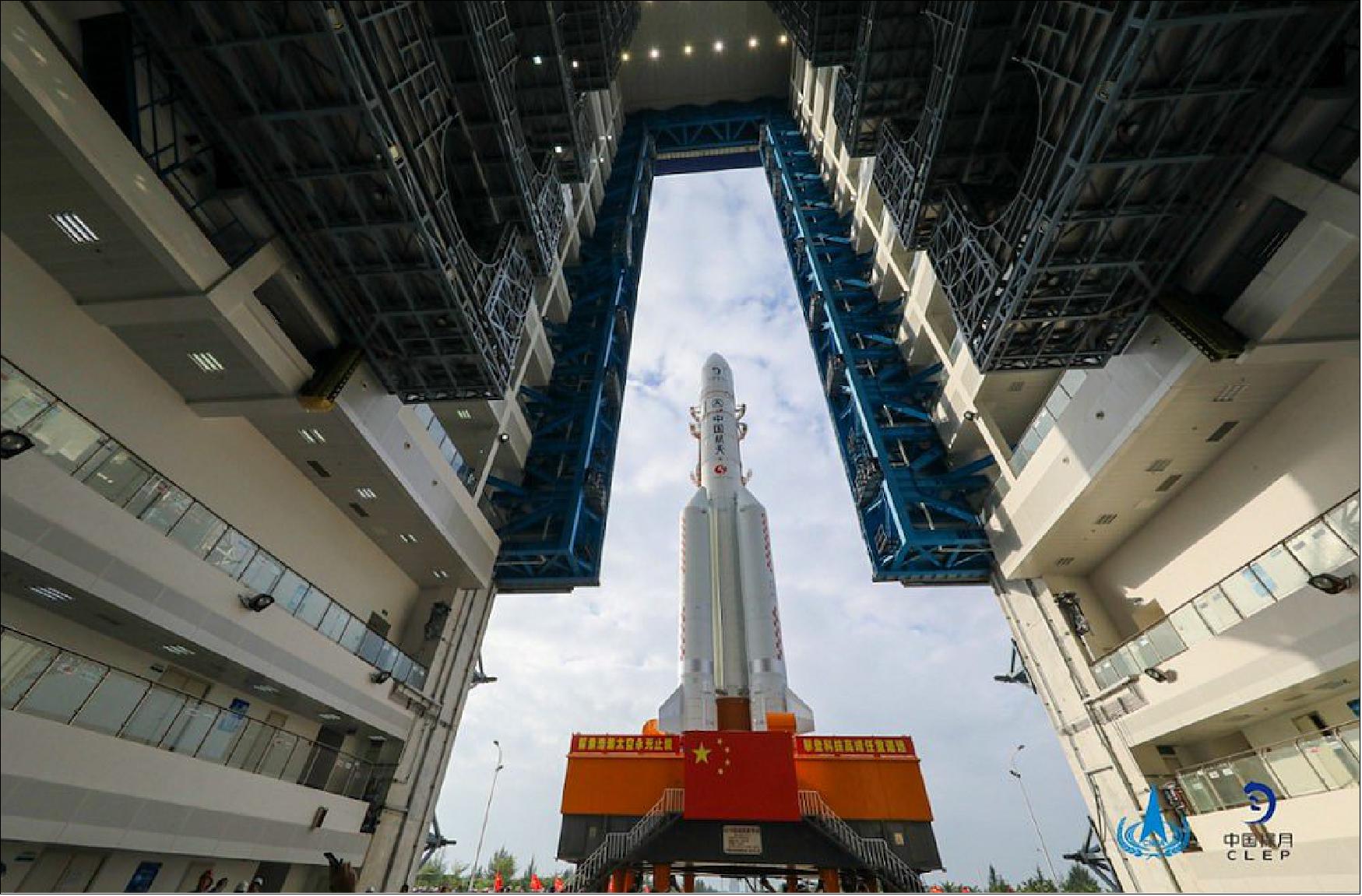
- The 57-meter Long March 5 heavy-lift carrier rocket, which weighs about 870 metric tons, was vertically placed on a mobile platform that moved about two hours before transporting the gigantic rocket to a coastal launch pad, the administration said in a statement.
- The launch has been scheduled to take place before the end of this month, it noted.
- The rocket was transported to a port in Wenchang by ships in late September and was then carried by special trucks to the launch center.
- Over the past two months, it was assembled and examined at the center, the administration said, adding that when final checks are done, propellants will be pumped into it.
- The sixth mission in the Chang'e program, Chang'e-5 will be one of the most difficult and challenging endeavors China has ever embarked on and will become the world's first space operation in more than four decades to bring lunar samples back the Earth.
- Its findings will facilitate scientists' research on the moon's origin and evolution, according to the administration.
- The 8.2-metric ton Chang'e 5 has four components - orbiter, lander, ascender and reentry module. After the probe reaches the lunar orbit, the components will separate into two parts, with the orbiter and reentry module remaining in the orbit while the lander and ascender descend toward the moon's surface.
- The lander and ascender will make a soft landing and then get to work on such tasks as using a drill to collect underground rocks and a mechanical arm to gather surface soil.
- After the surface operations are done, the ascender's rocket will elevate it to lunar orbit to dock with the re-entry module. It will transfer lunar samples to the module, which will carry them back to Earth.
- Considering these highly sophisticated operations, Chang'e-5 will be more difficult and challenging than previous Chinese lunar expeditions, designers have said.
- If the Chang'e-5 mission becomes successful, it will make China the third nation in the world to bring lunar samples back after the United States and Russia, and will also make Chang'e-5 the world's first lunar sample-return mission since August 1976 when the former Soviet Union's unmanned Luna-24 brought 170.1 grams of lunar samples to the Earth.
- In January 2004, the central government approved the lunar exploration program's plan and officially opened its research and development work.
- The first Chang'e probe was launched in October 2007. Since then, China has launched four lunar probes, with the third being the first Chinese spacecraft to soft-land on the moon's surface.
- The latest and most remarkable, the ongoing Chang'e-4 mission, is the first endeavor by any nation to conduct surface observation of the moon's far side, which never faces Earth, thereby accomplishing a goal sought by scientists for decades.
Launch
The Chang'e-5 spacecraft of CNSA was launched on a Long March 5 (CZ-5) heavy lift vehicle on 23 November 2020 (20:30 UTC, corresponding to 4:30 Beijing Time on 24 November 2020) from the Wenchang Space Center on the island of Hainan, China. 9)
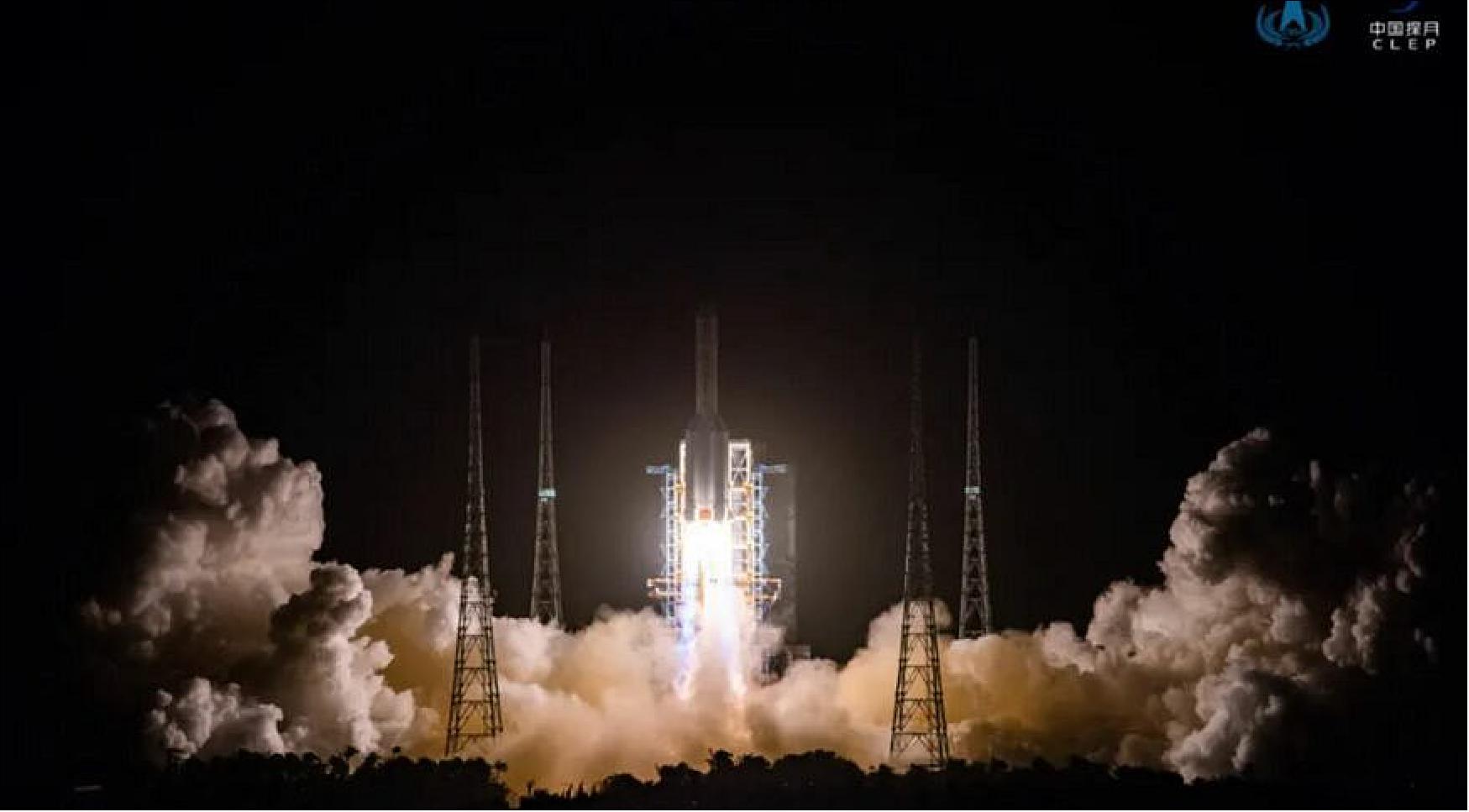
The Chang’e-5 spacecraft was announced to have successfully entered its predetermined orbit around 21:45 UTC, following deployment of solar arrays. The 8.2-ton Chang’e-5 spacecraft is to begin an estimated 112-hour journey to the moon.
The mission aims to collect the youngest samples so far obtained from the moon and later land in Siziwang Banner, Inner Mongolia, around Dec. 15-16. Samples will then be transferred to specially developed facilities for handling, analyzing and storing the lunar material.
Major challenges following launch include carrying out liftoff of an ascent vehicle from atop the lander spacecraft on another planetary body, as well as a later automated lunar orbit and rendezvous around 380,000 km from Earth.
Mission Timeline
A detailed timeline of the mission has not been released by China. The spacecraft is expected to be inserted into a roughly 200-kilometer altitude lunar orbit shortly after sunrise over the designated Mons Rümker on November 27.
The landing attempt is expected in the days following. Chinese language journals detailing the Chang’e project technology roadmap state that sampling activities will last around two Earth days. Around two kilograms of drilled and scooped samples will then be sent into lunar orbit by a roughly 500-kilogram ascent vehicle. A two-day period will conclude with rendezvous and docking between the ascent and service modules. The samples will be transferred to a reentry capsule attached the service module.
The service will then separate from the ascent vehicle and remain in lunar orbit until an opportune window to return to Earth. The reentry vehicle will separate from the service module around 5,000 kilometers from Earth. A skip reentry, involving bouncing off the atmosphere—a maneuver tested by the Chang’e-5 T1 mission in 2014—to deal with the high-velocity return from the moon will follow. ESA tracking stations will support this critical phase as the spacecraft attempts reentry.
Samples will then be transferred to specially constructed facilities for handling, analyzing and storing the lunar material.
Science Goals
The stated landing area surrounds Mons Rümker, a volcanic peak situated in the Oceanus Procellarum region of the western edge of the near side of the moon. The area may contain geological units of basaltic rock as young as around 1.21 billion years old. By comparison, samples brought to Earth by Apollo astronauts are aged between 3.1 and 4.4 billion years old.
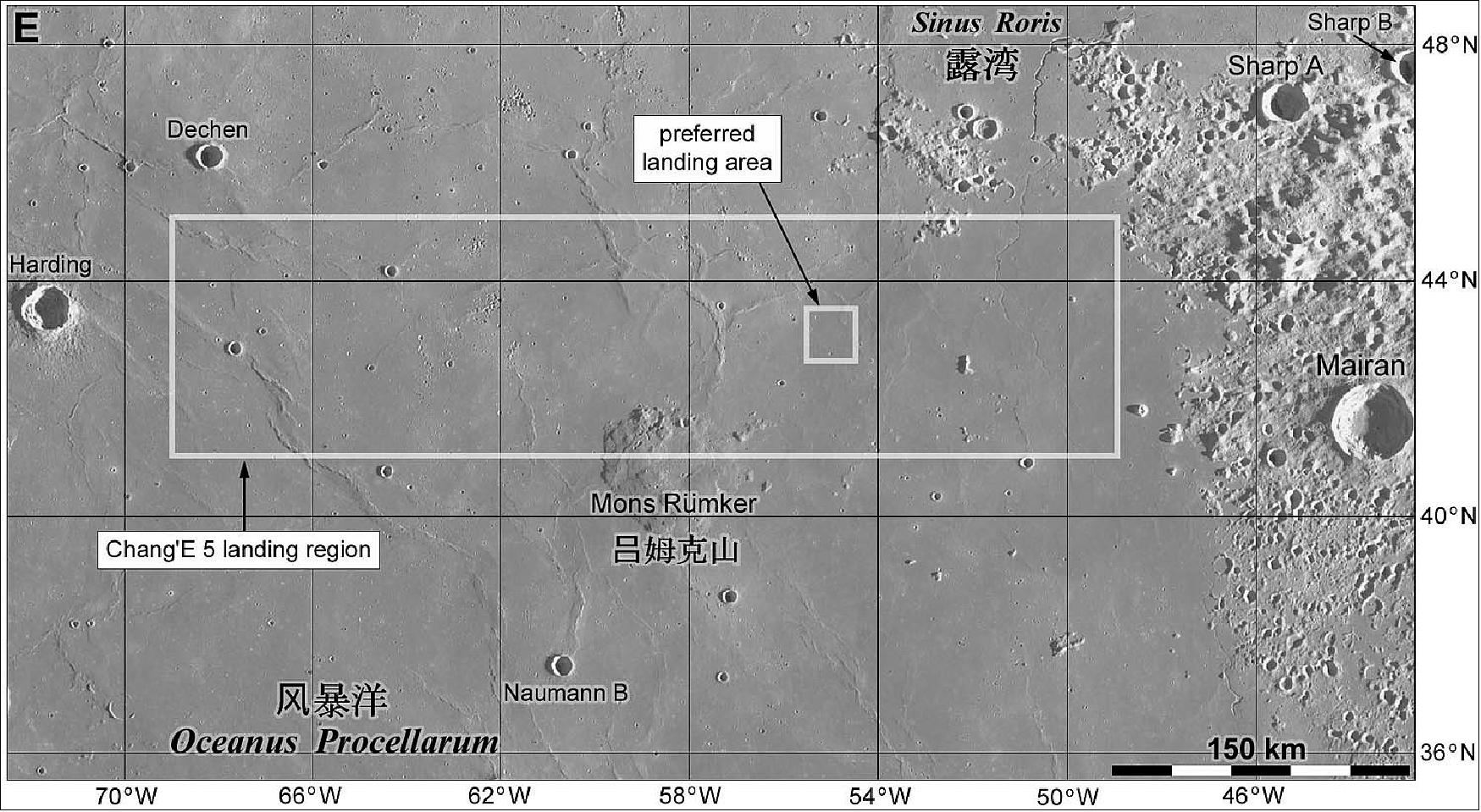
It is hoped that such geologically young samples, if returned, will allow radiometric dating of the samples to verify the age of the area. It could also then provide valuable information about the apparent late-stage volcanism needed to create the relatively new units of rock. The combination of orbital observations of cratering and accurate dating of samples would both help constrain chronologies on the moon and be applied as a reference for terrestrial bodies across the solar system.
The Chang’e-5 lander also carries a panoramic camera, lunar penetrating radar and imaging spectrometer for observation and analysis of the landing area.
Mission Status
• February 15, 2022: A spacecraft involved in China’s 2020 Chang’e-5 lunar sample-return mission is now in a unique orbit around the Moon, more than a year after completing its primary mission. 10)
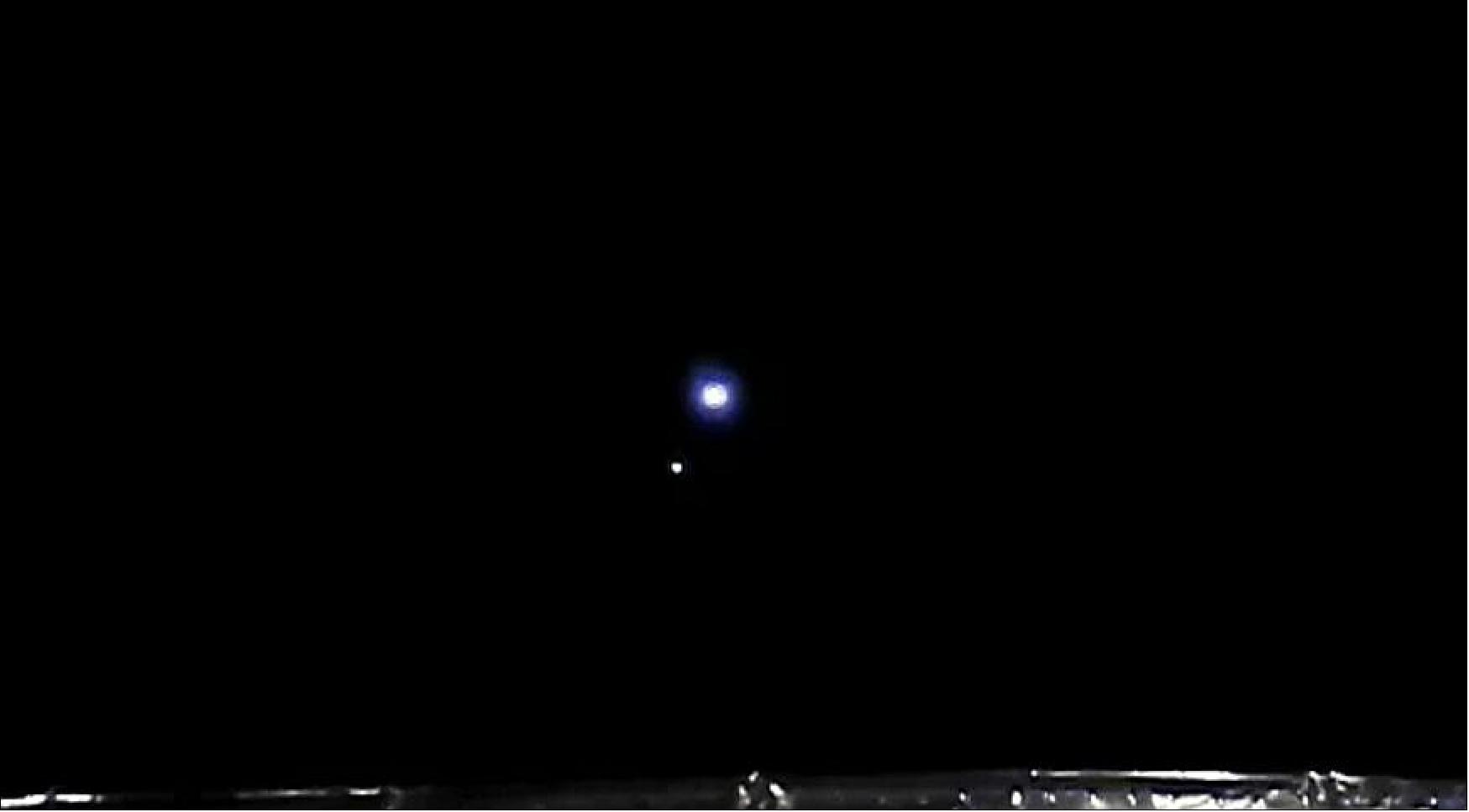
- The service module, which played a large part in delivering 1.731 kg of fresh lunar samples to Earth in December 2020, is now in a distant retrograde orbit (DRO) of the moon, according to amateur satellite trackers.
- China has not published an update on Chang’e-5’s activities since May 2021, when the China Lunar Exploration Program released images the spacecraft had taken from deep space.
- However amateur satellite tracker Scott Tilley and others, including Jean-Luc Milette and Edgar Kaiser, have been following Chang’e-5’s travels through space and provide evidence for the new lunar orbit following months of observations.
- A distant retrograde orbit sees a spacecraft interact with two gravitationally stable areas in front of and behind the moon with respect to the Earth. The spacecraft’s distance from the moon means it orbits only once every couple of weeks.
- Such an orbit has not been used before, but is planned to be utilized by NASA’s upcoming Artemis 1 mission later this year. The agency’s canceled Asteroid Redirect Mission also considered using a DRO.
- Nailing down the orbit of Chang’e-5 was a challenge, Tilley told SpaceNews in an email, citing the limited size of antennae available to amateur trackers and equipment calibration. “The primary issue for amateurs was obtaining high accuracy positional locations of the spacecraft in the sky,” says Tilley.
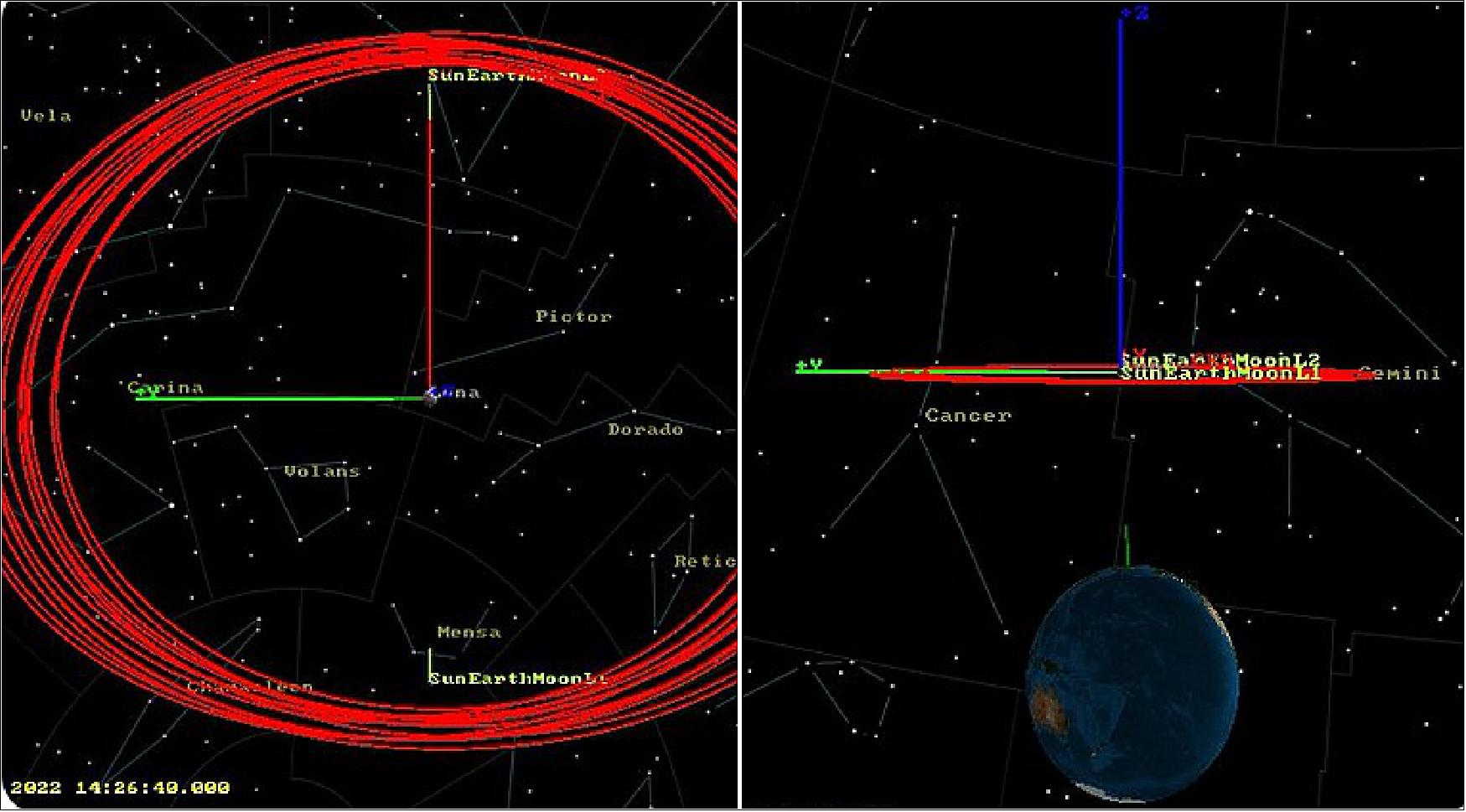
- However public collaboration between trackers across the world helped constrain the apparent path of the spacecraft, says Tilley, who has tracked Chang’e-5 from soon after its launch in November 2020 and helped provide up-to-date information, as China did not publicly reveal the entire mission timeline and major milestones in advance.
- “That’s why I found this latest part of tracking Chang’e-5 the most satisfying. It boiled down to a purely amateur effort.”
- It is unclear what China is planning with the DRO test, but Chang’e lunar missions have earlier been sent on extended missions to add value or even as important tests for later missions.
- Chang’e-2 conducted a flyby of the near Earth asteroid Toutatis in 2012 after completing its mapping of the moon. The service module for the 2014 Chang’e-5 T1 mission, a test run for a sample-return, was used to test out orbiting at Earth-moon Lagrange point 1.
- This gave the first hint that China was considering a then-unannounced lunar far side landing mission with Chang’e-4. Incidentally the upper stage of the Long March 3C used to launch the mission is set to impact the moon in March.
- However spacecraft activity tracker Jonathan McDowell, also an astrophysicist at the Harvard-Smithsonian Center, told SpaceNews that he believes China is probably using the Chang’e-5 spacecraft gaining experience with astrodynamics.
- “They are using it as a toy to play around with. It is clearly useful as a stable lunar orbit for future missions, I just don’t think it’s a specific precursor.”
- China plans to launch a near Earth asteroid sample-return mission around 2024, but while the mission will build on experience and engineering from Chang’e-5, the mission profile does not suggest use of a lunar DRO.
Mission History
- Chang’e-5 was primarily a complex, three-week-long mission to collect fresh lunar samples from the near side of the moon. Launching from Wenchang on a Long March 5 rocket in November 2020, the mission involved the orbiter, a lander, an ascent vehicle and a return capsule.
- The lander perished after sunset over its landing site due to intense cold of the lunar night, while the ascent vehicle was commanded to impact the moon after carrying the samples into orbit, docking with the orbiter, and transferring the lunar payload to a return capsule. The return capsule was recovered in Siziwang Banner in Inner Mongolia after reentry into Earth’s atmosphere.
- Portions of the samples are now being studied by Chinese and international scientists. Research has included dating the rock samples, analyzing composition and volatile content, oxygen extraction, refining the ages of planetary bodies and more.
- However, after releasing the capsule containing samples collected from Oceanus Procellarum, the orbiter itself continued its journey away from Earth, heading for the Sun-Earth Lagrange point 1, roughly 1.5 million kilometers away. The spacecraft is using extra fuel thanks to the precise initial orbital injection by the Long March 5.
- The spacecraft entered orbit around this gravitational stable point in March 2021. There it conducted space environment tests and solar and Earth observations under the control of the Beijing Aerospace Control Center (BACC).
- Jing Peng, deputy chief designer of the Chang’e-5 spacecraft system at the China Academy of Space Technology (CAST), said during the Global Space Exploration (GLEX) conference in St. Petersburg, Russia, in June 2021, that a visit to a planetary body such as Venus may not be possible due to a lack of propellant.
- “I don’t think there will be many opportunities for the orbiter to perform more complex orbit maneuvers with other bodies,” he said. “I think it will stay in Lagrange point 1 or the Earth-moon system,” Peng said.
- The orbiter returned to the Earth-moon system in September 2021, again tracked by enthusiasts.
- China is planning to launch another moon sample-return, Chang’e-6, around 2024, following the launch of the multi-spacecraft Chang’e-7 orbiter, lander, relay satellite and rover mission.
- The country is also planning an International Lunar Research Station on the moon’s surface in collaboration with Russia.
• January 12, 2022: A joint research team led by Profs. LIN Yangting and LIN Honglei from the Institute of Geology and Geophysics of the Chinese Academy of Sciences (IGGCAS) observed water signals in reflectance spectral data from the lunar surface acquired by the Chang'E-5 lander, providing the first evidence of in-situ detection of water on the Moon. 11)
- Researchers from the National Space Science Center of CAS, the University of Hawai'i at Manoa, the Shanghai Institute of Technical Physics of CAS and Nanjing University were also involved in the study.
- Many orbital observations and sample measurements completed over the past decade have presented evidence for the presence of water (as hydroxyl and/or H2O) on the Moon. However, no in-situ measurements have ever been conducted on the lunar surface.
- The Chang'E-5 spacecraft landed on one of the youngest mare basalts, located at a mid-high latitude on the Moon, and returned 1,731 g of samples. Before sampling and returning the lunar soil to Earth, however, the lunar mineralogical spectrometer (LMS) onboard the lander performed spectral reflectance measurements of the regolith and of a rock, thereby providing the unprecedented opportunity to detect lunar surface water.
- Water (OH/H2O) can be detected using spectral features at ~3 µm. However, above 2 µm, thermal emission from the hot lunar surface will significantly modify and mask spectral features.
- Therefore, the researchers used a thermal correction model to correct the LMS spectra. Following this correction, the undoubted spectral absorptions at 2.85 µm were observed at the Chang'E-5 landing site.
- The quantitative spectral analysis indicates that the lunar soil at the landing site contains less than 120 ppm of water, which is mostly attributed to solar wind implantation. This is consistent with the preliminary analysis of the returned Chang'E-5 samples.
- In contrast, a light and vesicular rock that was also analyzed exhibited much stronger absorption at 2.85 µm, corresponding to an estimated ~180 ppm of water, thus suggesting an additional water source from the lunar interior.
- The results of compositional and orbital remote sensing analyses show that the rock may have been excavated from an older basaltic unit and ejected to the landing site of Chang'E-5. Therefore, the lower water content of the soil, as compared to the higher water content of the rock fragment, suggests that degassing of the mantle reservoir beneath the Chang'E-5 landing site took place.
- This discovery is consistent with the prolonged volcanic eruptions in the Procellarum KREEP (potassium, rare earth elements, phosphorus) Terrain region, and also provides vital geological context for the analysis of the returned Chang'E-5 samples.
- This work was supported by the Strategic Priority Research Program of CAS, the Key Research Program of Frontier Sciences of CAS, the Key Research Program of IGGCAS and the National Natural Science Foundation of China. 12)
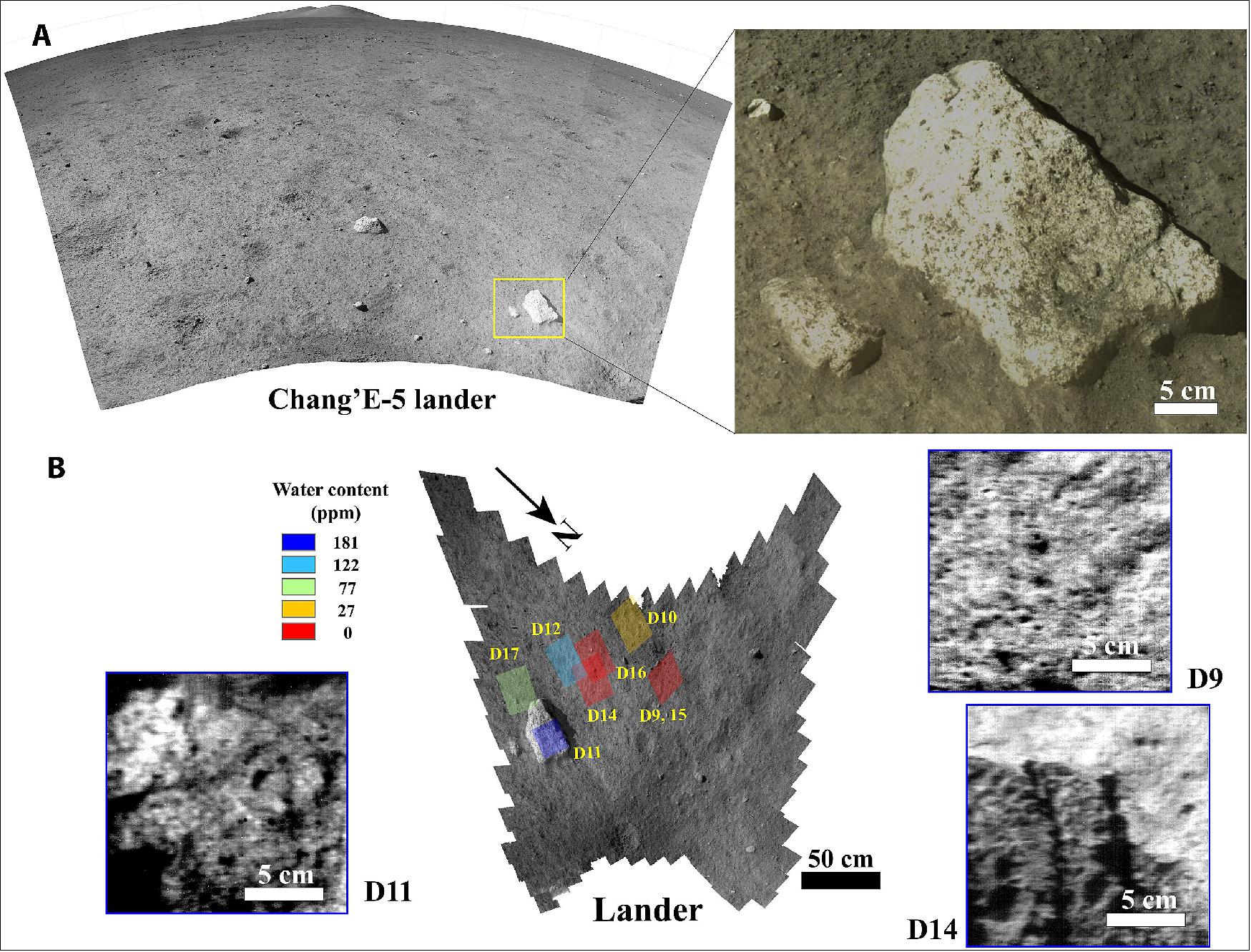
• October 21, 2021: Chinese researchers have studied the lunar samples brought back by the Chang'e-5 mission and dated the youngest rock on the Moon at around 2 billion years in age, extending the "life" of lunar volcanism 800-900 million years longer than previously known. 13)
- The study, conducted mainly by a research team at the Institute of Geology and Geophysics (IGG), Chinese Academy of Sciences (CAS), was presented in three Nature papers and published online Tuesday. 14)
- Last year, China's Chang'e-5 mission retrieved samples from the Moon weighing about 1,731 kg, which were the first lunar samples in the world in over 40 years.
- "The Chang'e-5 mission was a success and the lunar samples brought back shed new light on the evolution of the Moon," said Li Xianhua, an academician with CAS who led the research team.
Dating Moon Rocks
- "The magma of the Moon has solidified, and the Moon's geologic activity has already ceased. When the Moon's volcanic activity stopped, it emerged as one of the major issues in its evolutionary history," said Li Qiuli, head of the secondary ion mass spectrometry laboratory of IGG.
- The youngest dated rock from the Apollo and Luna missions and lunar meteorites was around 2.8-2.9 billion years old. However, more samples are needed and one of the Chang'e-5 tasks is to explore the youngest magmatic activity of the Moon.
- "The dimply surface we see when we look up at the Moon through a telescope is due to the fact that many asteroids have collided with it over billions of years. Older rocky regions have experienced more impact craters over time, and regions with younger rocks have fewer craters," said Li Qiuli.
- Using the method of chronology known as crater counting, researchers inferred that the Oceanus Procellarum, the landing site of the Chang'e-5 mission, was most likely to have been witness to one of the Moon's last volcanic eruptions. Researchers could then calibrate the results from crater counting with radioisotopically dated samples.
- Radioisotopic dating works on the principle that radioactive elements have constant decay rates. By measuring the relative abundances of the parent and daughter isotopes, researchers will know how long the decay has been taking place.
- Using the microscope, researchers manually picked out rock fragments from their 3-gram lunar samples, which is as difficult as separating black flour from white flour by hand. Most of these minerals suitable for dating are only one-twentieth of the diameter of a hair.
- Li Qiuli said that the research team had been well-prepared for studying the lunar samples retrieved by China, and has continuously developed the ion probe technology in the past decade, reaching an internationally acclaimed level of expertise.
- "Our palms were sweaty as we loaded the sample and turned on the mass spectrometer. When we saw the age it spat out, we couldn't believe our luck. But we wanted to be sure," said Li Qiuli, adding that they carried out more than 200 tests.
- In total, the team analyzed 47 different rock fragments extracted from the sample materials and dated the youngest rock on the Moon at 2.03 billion years old. The new age extends the life of lunar volcanism 800-900 million years longer than previously known.
Out Of Expectation
- ”The Moon is only around one percent the mass of Earth. At that strikingly small size, theoretically, at least, it should have completely solidified at a quick pace. Our team investigated further why volcanic activity still existed on the Moon so late," said Li Xianhua.
- Lunar scientists focused on KREEP, an acronym built from the letters K (for potassium), REE (for rare-earth elements) and P (for phosphorus), which is a distinctive geochemical component of some lunar rocks.
- "A widely accepted hypothesis is that radioactive elements (U, Th and K) supplied the heat necessary for the late volcanic activity. Because KREEP is rich in radiogenic elements U, Th and K, it is therefore thought to be responsible for the young volcanic activity," said Yang Wei, a researcher with IGG.
- "Isotopes are an effective way to identify the KREEP component as they are like the DNA of a rock and will not change through the magmatic evolution," said Yang.
- However, the difficulty lies in the small size of the basalt clasts in the Chang'e-5 lunar samples. It is hard to obtain the isotope ratios of the Chang'e-5 basalt.
- "It's like DNA testing, which requires a large tube of blood, but we can only use one drop," said Yang.
- Thanks to the institute's efforts over a decade, a state-of-the-art method for analyzing samples under high magnification has been developed, allowing researchers to obtain the strontium and neodymium isotope ratios of specific minerals.
- The results were beyond expectations. The Chang'e-5 basalt, the youngest basalt dated on the Moon so far, originated from a depleted mantle source with a KREEP component measuring less than 0.5 percent of its weight.
- In other words, it is unlikely that the KREEP components in the lunar mantle supplied the heat necessary for the late volcanic activity.
Water Content
- Another possible cause of volcanic activity on the Moon at such a late age is that the mantle source might have contained water to reduce its melting point, said scientists.
- "The water content of the lunar mantle is a key question for lunar exploration because it provides critical constraints on the formation of the Moon. Furthermore, since water can significantly decrease the melting temperature of rocks, understanding its abundance is important for understanding the history of lunar volcanism," said Lin Yangting, a researcher with IGG.
- The large discrepancy in water abundance estimates of the lunar mantle could be mainly attributed to the Apollo samples and lunar meteorites being generally quite old.
- Most previous lunar samples with measured water content date back to 3 billion years or earlier. Such old rocks could have undergone heavy modifications over a long time by the impact of asteroids and particles from the sun.
- "The samples retrieved by Chang'e-5 were from a single basaltic lava flow. With such a simple and clear geological setting, the samples, therefore, provide a good opportunity to address the question of whether the mantle reservoir at 2 billion years was wet or dry," said Lin.
- The research team analyzed the water contents and hydrogen isotopes of pockets of melt preserved in some minerals as well as the mineral apatite, which can contain water, from Chang'e-5 basalts.
- "We used a nanoscale ion probe called the nanoSIMS, a secondary ion mass spectrometer with an ion beam down to 50 nanometers in diameter. The relative abundances of the two isotopes of hydrogen (deuterium [D] and hydrogen [H]) can serve as a 'fingerprint' to trace the reservoirs of water and the magmatic processes involved," said Lin.
- The results indicated that the mantle source of the Chang'e-5 basalts was drier than the estimated water content based on the Apollo samples and lunar meteorites, which rules out the possibility that high water content in the mantle source was the cause of the usually young volcanic eruption.
- The mystery of the late lunar volcanic activity is yet to be solved.
- "Our discoveries raise new questions for the future of lunar exploration and scientists need to further explore the formation mechanism of the lunar magma," said Li Xianhua.
• April 15, 2021: China's space agency has released an online database of the first batch of the lunar samples brought back by the Chang'e-5 probe. 15)
- Researchers and the public can access the Lunar and Deep Space Exploration Scientific Data and Sample Release System via the website www.clep.org.cn, where they can apply for data and samples, according to the China National Space Administration, which announced the release of the database Tuesday (13 April).
- The Chang'e-5 probe, which returned to Earth on Dec 17, 2020, retrieved a total of 1,731 grams of lunar samples, mainly rocks and soil from the lunar surface.
- According to China's lunar sample management regulations, the lunar samples will be generally used for four purposes, namely permanent storage, backup permanent storage, research and public welfare.
• March 19, 2021: A spacecraft involved in China’s 2020 lunar sample return mission has entered orbit around Sun-Earth Lagrange point 1 (L1) as part of an extended mission. 16)
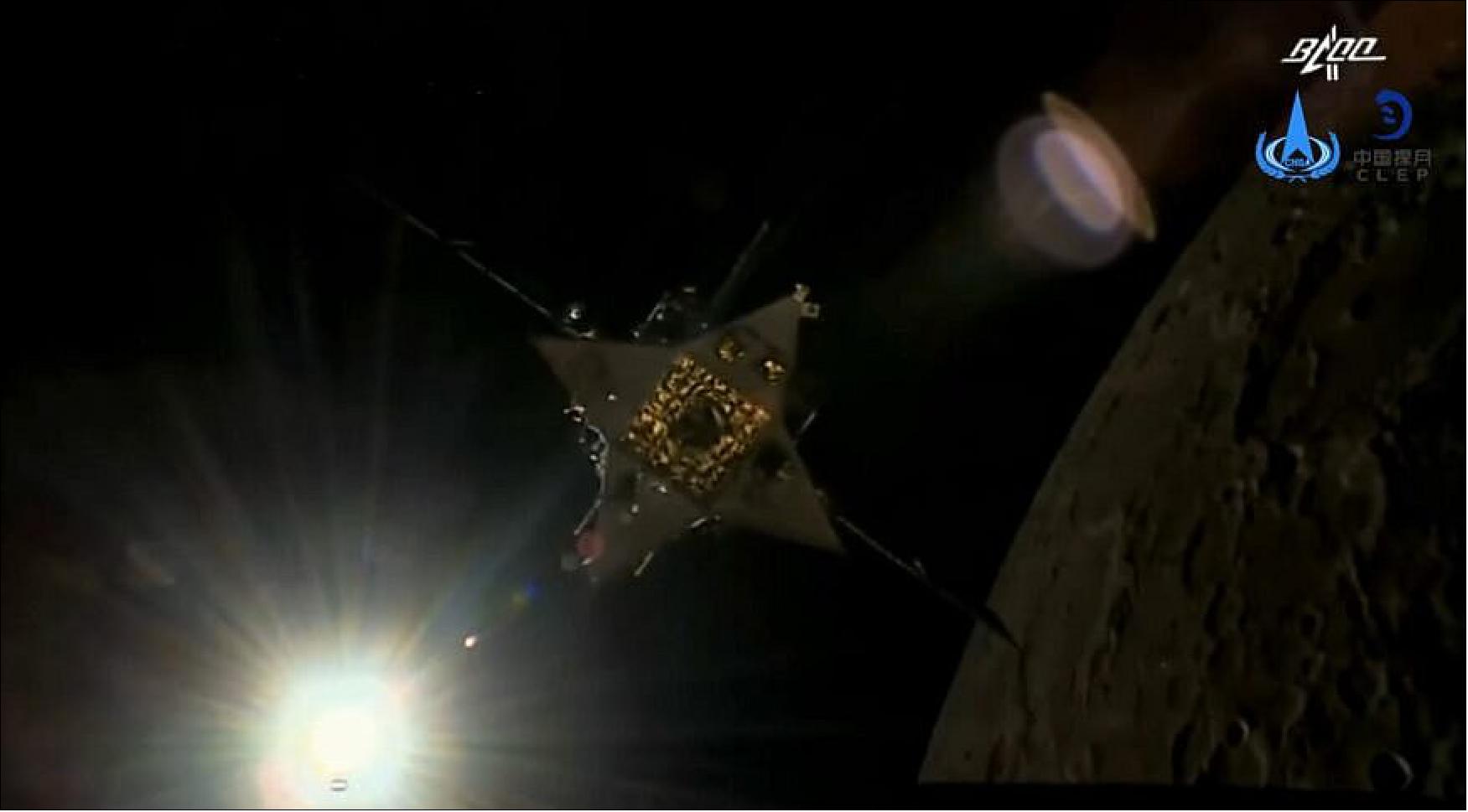
- The Chang’e-5 orbiter successfully entered an intended orbit around the Lagrange point at 1:29 a.m. EST March 15, the China Aerospace Science and Technology Corp. (CASC), the spacecraft’s manufacturer, stated March 19.
- The spacecraft will carry out a range of tests and solar observations under the control of the Beijing Aerospace Control Center (BACC). Possible future destinations for extended activities are being considered.
- The extended Chang’e-5 mission is China’s first excursion to Sun-Earth L1 and the first Chinese spacecraft to move inside the orbit of the Earth.
- The orbiter in December facilitated the delivery to Earth of a reentry capsule containing collected lunar materials. It then utilized propellant saved through a highly-accurate launch and trans-lunar injection to embark on an additional journey.
- Sun-Earth L1, located about 1.5 million kilometers from Earth, is one of a number of points near two large co-orbiting bodies at which gravitational and centrifugal forces are balanced, allowing spacecraft to maintain an orbit around with minimal station keeping.
- NASA’s DSCOVR deep space climate observatory mission is one of a number of spacecraft to have utilized Sun-Earth Lagrange point 1. The location of the Lagrange point makes it suitable to long term, unobstructed observations of the Earth and the Sun.
Return and Continuation
- The Chang’e-5 orbiter was instrumental in the successful collection of lunar material from Oceanus Procellarum late last year.
- The mission launched in late November and saw a lander spacecraft set down near Mons Rümker Dec. 1. Collected samples were delivered to the Chang’e-5 orbiter by an ascent vehicle following a robotic lunar orbit rendezvous and docking procedure.
- The orbiter left lunar orbit Dec. 12 along with a return capsule containing lunar samples. The two spacecraft separated around 5,000 km from Earth Dec 16., with the return capsule performing a ‘skip’ reentry into the atmosphere.
- The return capsule landed at 12:59 EST Dec. 16 with 1.731 kg of lunar materials. The orbiter performed a maneuver to set it on a course for Sun-Earth L1.
- Possible future scenarios for the Chang’e-5 orbiter could include visiting the Sun-Earth L4 or L5 points. These triangular libration points located 60 degrees ahead and behind Earth in its orbit are more stable than the other three points and could harbor near-Earth objects. Imagers could be used to survey the region for speculated Earth Trojan asteroid objects.
- Potential visits of Venus or 469219 Kamo'oalewa (2016 HO3), the stated target for China’s 2024 Zhenghe near-Earth asteroid sampling mission, are considered unlikely based on estimates of remaining propellant and required changes in velocity.
Lunar Far Side Update
- China’s ongoing Chang’e-4 lunar far side mission is meanwhile expected to complete its 28th lunar Day Saturday, March 20.
- The January 2019 landing marked the first soft landing on the lunar far side, with communications facilitated by a relay satellite stationed in orbit around Earth-moon Lagrange point 2 beyond the moon.
- The Chang’e-4 lander and Yutu-2 rover have been operating on the moon for over Earth 800 days. The solar-powered spacecraft enter a hibernation state for the intensely cold lunar nights.
- The Yutu-2 rover has so far driven 652.62 meters across Von Kármán crater and is about 429 meters distant from the lander.
- The mission has produced data on the local subsurface structure, potential detection of material derived from the lunar mantle, diverse rock types and secondary crater fragments encountered by the rover, first radiation dose measurements from the lunar surface and local impact histories.
- China is next planning a number of Chang’e missions to the lunar south pole. These in concert with planned Russian missions are considered the starting point for a basic stage “International Lunar Research Station”, tentatively to be expanded into more permanent robotic facilities and potential crewed visits and long term stays.
• January 1, 2021: China's space industry has produced a remarkable scorecard this year: characterized by the nation's first independent Mars mission, the completion of a global navigation satellite network and a landmark adventure that retrieved rocks and soil from the moon. 17)
- The most significant event in China's space field, and also one of the most notable space activities globally, this year-the Chang'e-5 robotic mission-returned 1,731 grams of lunar rock and soil to Earth, marking a historic accomplishment 44 years after the last lunar substances were retrieved.
- The 23-day mission was China's first space journey to claim extraterrestrial samples, making it the third country to accomplish the feat after the United States and the former Soviet Union.
- In a letter published after the samples arrived on Earth, President Jinping Xi extended warm congratulations and sincere greetings to all participants on behalf of the Communist Party of China Central Committee, the State Council and the Central Military Commission.
- Xi said that as China's most complicated space project, the Chang'e-5 mission completed the national space industry's first extraterrestrial sampling and return. It was the latest achievement by China's system, which is characterized by its ability to mobilize all available resources to overcome difficulties and achieve its goals, and also marks a major step forward for the country's space industry, he said.
- The mission's results will contribute to mankind's deeper understanding of the moon's origins and the evolution of the solar system, he noted.
- "Your extraordinary feats will be enshrined in the memories of our motherland and the people," Xi wrote, referring to those involved in the mission.
- Chang'e-5, the nation's largest and most sophisticated lunar probe, was launched by a Long March 5 heavy-lift carrier rocket early on Nov 24 at the Wenchang Space Launch Center in South China's Hainan province.
- It was the world's first mission to bring lunar samples back to Earth since 1976.
- The 8.2-metric-ton spacecraft had four main components: an orbiter; lander; ascender; and reentry capsule. While in lunar orbit on Nov 30, the probe separated into two sections-the orbiter-reentry capsule combination and the lander-ascender combination.
Touchdown
- On Dec 1, the lander-ascender touched down on the moon, becoming only the third spacecraft to reach the lunar surface since the mid-1970s, following Chang'e-3 and Chang'e-4.
- Shortly after landing, the craft began drilling for samples 2 meters below the surface and using a mechanical arm to scoop up soil.
- The collection operation finished after about 19 hours, on Dec 2, much earlier than expected. The samples were packed into a specially designed vacuum container inside the ascender to avoid contamination.
- During the process, the lander unfurled the first free-standing Chinese national flag on the lunar surface, making China the second nation to place such an emblem on the moon after the US.
- On Dec 3, the ascender lifted itself into an elliptical lunar orbit to dock with the reentry capsule, thus marking the first time a Chinese spacecraft had blasted off from an extraterrestrial body. It linked up with the orbiter-reentry capsule combination on Dec 6 and transferred the lunar samples.
- The ascender separated from the orbiter-reentry combination later that day and was deliberately crashed into the moon on Dec 8 to prevent it becoming space debris.
- The combination made several preparatory maneuvers during lunar orbit and entered a moon-Earth transfer trajectory on Dec 13 to begin its flight back to Earth.
- Early on Dec 17, the reentry capsule separated from the orbiter about 5,000 kilometers above the southern Atlantic Ocean and began its descent.
- It touched down at a preset landing site in Siziwang Banner, Inner Mongolia autonomous region, at 1:59 am, ending a mission that had been closely followed by scientific communities and media around the globe.
- The sealed samples were transferred to a specially designed laboratory at the Chinese Academy of Sciences and will later be distributed to researchers for analysis, experiments and tests.
- "Research on lunar samples is one of the most important ways we can learn about the past, present and future of the moon, and also provides great help when scientists investigate the evolution of other members of our solar system," said Hongfeng Guo, a National Astronomical Observatories researcher.
- Some of the samples will be put on display to boost scientific awareness, especially among the younger generation.
- "This will greatly encourage people, especially young people, to study and explore the worlds beyond Earth," Xiao Long, a planetary geologist at the China University of Geosciences in Wuhan, Hubei province, told Nature magazine.
- Officials at the China National Space Administration have welcomed cooperation from foreign scientists in researching the samples.
Interplanetary Journeys
- In addition to the moon, China's space authorities are looking farther into the solar system. They took the first step in the country's interplanetary voyage during the summer.
- On July 23, Tianwen 1, China's first independent Mars mission, was launched from the Wenchang center by a Long March 5 rocket, opening the nation's planetary exploration program.
- By the middle of this month, the 5-ton spacecraft-consisting of an orbiter and a landing capsule-was 100 million km from Earth, about 12 million km from Mars, and had traveled nearly 360 million km, according to the space administration.
- If everything goes according to schedule, the probe will travel more than 470 million km before being captured by Mars' gravitational field in February, when it will be 193 million km from Earth.
- Depending on the two planets' orbits, Mars is 55 million km to 400 million km from Earth.
- After entering Mars' orbit, the spacecraft will circle the planet for two and a half months to examine the preset landing site before descending to release the capsule, which will fall gradually through the atmosphere.
- The mission's goal is to deploy a rover in May on the southern part of Utopia Planitia-a vast plain within Utopia, the largest known impact basin in the solar system-to conduct scientific surveys.
- Weighing about 240 kg, the rover, which has yet to be named, has six wheels and four solar panels, and can move at 200 meters an hour on Mars.
- It carries six scientific instruments including a multispectral camera, ground-penetrating radar and a meteorological sensor.
- It is expected to work for about three months, and if the semi-autonomous machine functions well, it will become the fifth rover to be deployed on Mars, following four US predecessors.
- If Tianwen 1 can fulfill its objectives-orbiting Mars for comprehensive observation, landing on the planet's surface and deploying a rover to conduct scientific operations-it will become the first Mars expedition to accomplish all three goals with one probe, according to Peijian Ye, a leading deep-space exploration scientist at the China Academy of Space Technology.
- Tianwen 1 is the 46th exploration mission to the red planet since October 1960, when the former Soviet Union launched the first Mars-bound spacecraft. Only 17 of those missions were successful.
Global Network
- In late June, the final satellite to complete the third-generation network of the BeiDou Navigation Satellite System was launched by a Long March 3B rocket at the Xichang Satellite Launch Center, Sichuan province, and placed in a geostationary orbit about 36,000 km above Earth.
- After in-orbit tests, the satellite-the 59th in the BeiDou family and 30th in the 3G series-started formal operations in late July, marking the start of BeiDou's provision of full-scale global services.
- BeiDou is China's largest space-based system and one of four global navigation networks, along with the GPS of the US, Russia's GLONASS and the European Union's Galileo.
- More than 300,000 scientists, engineers and technicians from more than 400 Chinese institutes, universities and enterprises have been involved in BeiDou's development and construction.
- Since 2000, 59 BeiDou satellites, including the first four experimental models, have been launched from Xichang on 44 Long March 3 series rockets. Some have already been retired.
- The system began providing positioning, navigation, timing and messaging services to civilian customers in China and other parts of the Asia-Pacific region in December 2012. At the end of 2018, it began providing basic global services.
- There are now 30 3G BeiDou satellites: 24 in medium-Earth orbit; three in inclined geosynchronous satellite orbit; and three in geostationary orbit.
- Some 2G BeiDou satellites are also in operation and offering regional services, according to the China Satellite Navigation Office.
- Compared with 2G satellites, 3G models offer greater accuracy and stability, a clearer signal and more state-of-the-art technology such as intersatellite links, satellite-based augmentation and global emergency search capabilities.
- In addition to space-based assets, BeiDou has a ground-based network that includes dozens of stations, more than 200 subsystems and over 30,000 sets of equipment.
Expanding Fleet
- The Chinese space sector's most recent accomplishment came on Tuesday (Dec. 29), when the newest carrier rocket-the Long March 8-made its maiden flight from Wenchang.
- The 50-meter, medium-lift rocket transported five experimental satellites into a sun-synchronous orbit at an altitude of 512 km.
- Designed and built by the China Academy of Launch Vehicle Technology, the rocket is tasked with meeting surging demand for launch services from commercial satellite companies at home and abroad.
- Xiao Yun, the rocket's project manager, said the successful maiden flight was a new achievement in China's efforts to upgrade its medium-lift launch vehicle system, and will push forward the nation's efforts to become a world-class space power.
- The rocket's services will also give a strong boost to the development and deployment of satellites operating in low-and medium-altitude orbits, he said.
- The vehicle has two core stages and two side boosters. Its six engines are propelled by liquid oxygen, liquid hydrogen and kerosene.
- With a liftoff weight of 356 tons, it is capable of sending 4.5-ton payloads into a sun-synchronous orbit 700 km above Earth, or satellites with a combined weight of 2.8 tons into a geostationary transfer orbit, the academy said.
- Project managers have estimated that at least 10 Long March 8s will be used every year, given the robust demand from domestic and international satellite companies, while annual manufacturing capacity will soon reach 20.
- To improve the rocket's competitiveness, it is expected to eventually become the first reusable Long March model.
- The designers intend to develop an integrated first stage for a reusable variant, consisting of a core booster and two side boosters.
- Instead of breaking up and falling back to Earth like similar stages of previous Chinese rockets, the new core and side boosters will stay together and make powered landings on a recovery platform at sea.
- About eight months ago, also in Wenchang, the Long March 5B heavy-lift carrier rocket undertook its maiden mission, transporting a prototype of China's new-generation manned spacecraft into a low-Earth orbit.
- The rocket is 53.7 meters long, with a core-stage diameter of 5 meters, and has a liftoff weight of 849 tons. It is the most powerful Chinese rocket in terms of carrying capacity for low-Earth orbit.
- The Long March 5B is central to the nation's space station program as it is the only Chinese launch vehicle capable of carrying large space station parts into orbit.
- In the next two years, three Long March 5B flights will put major components of China's space station into orbit for assembly.
- The multimodule station, Tiangong or Heavenly Palace, will have three sections-a core module and two space labs-with a combined weight of more than 90 tons.
- It is expected to become fully operational before the end of 2022 and to operate for about 15 years.
- Meanwhile, the new-generation manned spaceship has two main sections-the reentry and service modules. Tasked with serving the space station program, it employs world-class designs and technologies, and features great reliability and flexibility, multiple functions and reusability.
- The craft is 8.8 meters long, has a diameter of 4.5 meters, and a liftoff weight of 21.6 tons.
- The reentry module will house the crew and control the craft during spaceflight, while the service module will contain the power and propulsion systems.
- Designers at the China Academy of Space Technology said that compared with the Shenzhou series, the country's operational crewed spacecraft family, the new model is capable of longer missions, housing more astronauts and cargo and operating in tougher environments.
• January 1, 2021: China's Chang'e-5 probe retrieved about 1,731 grams of samples from the moon. It has been much anticipated just how these would be used for research. 18)
- Researchers have set up special storage facilities, constructed laboratories for sample processing and analysis, and developed detailed operating procedures to ensure that lunar samples are not contaminated as far as possible and that the research results are reliable.
- The samples will be first analyzed non-destructively, said Xiao Long, a researcher at the China University of Geosciences. He told the Science and Technology Daily that this analysis could indicate the condition of the samples.
- A method for non-destructive analysis is to obtain the samples' element composition and content information. Researchers do this by analyzing the wavelength and intensity of the characteristic fluorescence X-rays generated by different sample elements, said Yuyan Zhao with Jilin University.
- Researchers also implement microanalysis to use them as sparingly as possible. The allowable amount of the samples under test is usually only about one percent of the constant, with a weight of about 1 to 15 milligrams.
- Given the preciousness of lunar samples, it is necessary to further improve the sensitivity and resolution of the instruments, and develop new technologies and methods, said Zhao.
- By analyzing the samples, scientists can correct the previous mathematical models for estimating the surface age of celestial bodies. They can also provide significant references for humans to understand the geological evolution of the moon.
- Chang'e-5 is one of the most complicated and challenging missions in China's aerospace history. It is also the world's first moon-sample mission in more than 40 years.
- The Chang'e-5 probe, comprising an orbiter, a lander, an ascender, and a returner, launched on Nov. 24. The return capsule landed in Inner Mongolia Autonomous Region in the early hours of Dec. 17, bringing back the moon samples.
• December 21, 2020: The Chang'e-5 lunar mission has been declared a complete success after the reentry capsule carrying rock and soil samples from the moon landed safely in the designated area early on Thursday (Dec. 17). 19)
- Congratulations to all those who have participated in and contributed to this groundbreaking accomplishment. This is no doubt a solid step forward for the indigenous space industry, and potentially of great significance internationally.
- During the mission, Chang'e-5 accomplished a series of firsts for the country's space program - first collecting of samples from the moon, takeoff from surface of the moon, docking in lunar orbit, and returning with samples - and the spacecraft's return marked the first time scientists have obtained fresh samples of lunar rocks since 1976. It has put the perfect finishing touch to the Chinese lunar exploration trilogy of "orbiting, landing, returning".
- Meanwhile, as the most complicated systems engineering ever attempted by the domestic space industry, it has reportedly achieved a series of key technological innovations and breakthroughs that will greatly facilitate future lunar and interstellar missions.
- It was therefore a mission of milestone significance, one that represented "a great step forward for China's space industry", as President Xi Jinping said in a statement read out at the Beijing Aerospace Control Center. Industry insiders say it is comparable to that of the country's 1970 success in sending its first-ever man-made satellite into space, which announced the dawn of the space age in China. The Chang'e 5 mission means China has laid a solid foundation for the country's future plans for a permanent space station, manned missions to the moon and even Mars. Multiple interstellar missions have already been planned for the next decade.
- More interestingly, industry sources have disclosed that the planned Chinese lunar research station, which is a major goal of future Chinese lunar exploration, will be built "in an open and cooperative manner". The proposal has reportedly received positive responses from a number of countries and international organizations. This shows Chinese space industry's development is turning from independent indigenous endeavors to "all-around opening-up and cooperation".
- Speaking of lessons to be learned, while once again showing that the centralized mobilization mechanisms can harness the necessary resources, at the end of the day, it is about perseverance paying dividends. Everything would have been just castles in the air had it not been down-to-earth, no-nonsense, step-by-step approach generations of space industry workers have demonstrated for decades.
- It didn't matter to them this had been done more than four decades back by others. They knew the country had to blaze its own trail in order to catch up.
- More than anything else, it is that perseverance that has won the space industry the solid standing it can now take pride in.
• December 21, 2020: About 1,700 grams of lunar rocks and soil brought back by China's Chang'e 5 robotic probe were transferred to Chinese scientists for research on Saturday morning (Dec. 19), according to the China National Space Administration. 20)
- The samples were handed over by Zhang Kejian, head of the space administration, to Hou Jianguo, president of the Chinese Academy of Sciences, at a delivery ceremony in Beijing held by the space administration.
- The delivery marked the start of research into the samples, the administration said in a statement, adding that it will publish guidelines on the samples' distribution and use and will also encourage scientists from around the world to participate.
- The 8.2 metric ton spacecraft consisted of four main components-an orbiter, lander, ascender and reentry capsule.
- The probe separated into two parts - the orbiter-reentry capsule combination and the lander-ascender combination - while in lunar orbit on Nov. 30.
- On Dec. 1, the lander-ascender combination landed on the moon, becoming the world's third spacecraft to touch down on the lunar surface this century, after its predecessors - Chang'e-3 and -4.
- The collection operations finished on Dec 2, taking about 19 hours, which was much quicker than expected. Samples were packed into a vacuum container inside the ascender.
- During the process, the lander also unfurled the first free-standing Chinese national flag on the lunar surface.
- It linked up with the orbiting combination on Dec 6 and transferred the lunar samples into the reentry capsule. The ascender separated from the combination later that day and was commanded to impact on the moon on Dec 8.
- The combination made two orbital maneuvers over the weekend after traveling in a near-circular lunar orbit for nearly six days. After the maneuvers, the pair entered a moon-Earth transfer trajectory on Sunday and began to fly back toward Earth.
- The pair separated from each other early on Thursday morning, and the reentry capsule, laden with lunar samples, soon touched down on grassland on its preset landing site in Siziwang Banner of the Inner Mongolia autonomous region.
- The capsule was transported by plane to Beijing on Thursday afternoon, and was initially handled by experts at the China Academy of Space Technology.
• December 16, 2020: A capsule containing moon rocks landed in a remote, snow-covered corner of China Wednesday (Dec. 16), bringing home the first samples from the lunar surface in 44 years and completing the Chinese space program’s most challenging robotic mission to date. 21)
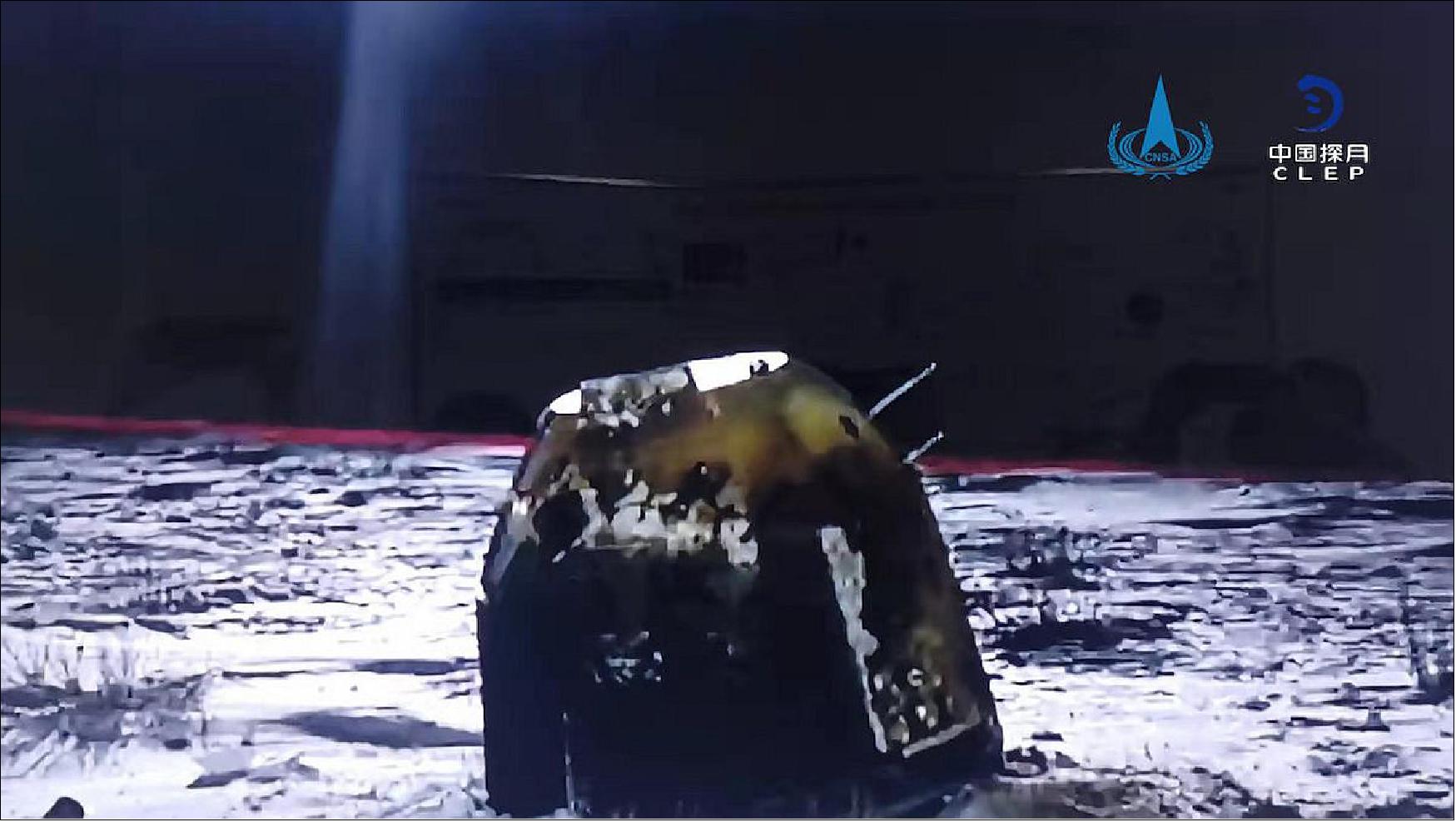
- Recovery crews dispatched to the remote landing zone converged on the capsule in helicopters and off-road vehicles, traveling across the snow-covered plains of Inner Mongolia in the middle of the night. Ground teams reached the Chang’e-5 return module within minutes to begin operations to secure the capsule, and planted a Chinese flag in the frozen soil next the spacecraft.
- Crews plan to transport the module to Beijing, where scientists will open the sample carrier and begin analyzing the moon rocks.
- “Congratulations to China on today’s return of lunar samples to Earth!” tweeted Thomas Zurbuchen, head of NASA’s science mission directorate. “The international science community celebrates your successful Chang’e-5 mission. These samples will help reveal secrets of our Earth-moon system and gain new insights about the history of our solar system.”
- The Chang’e-5 mission’s return to Earth capped a 23-day mission that successfully launched on China’s most powerful rocket Nov. 23, landed on the moon Dec. 1, collected samples, then took off again Dec. 3 to accomplish the first automated docking between two robotic spacecraft around another planetary body.
- Chang’e-5’s ascender vehicle linked up with the mission’s return spacecraft Dec. 5, then transferred the capsule containing the moon rocks to the return craft before jettisoning and intentionally crashing into the moon on Dec. 7.
- With those steps completed, all that was left was to bring the lunar samples back to Earth.
- Chang’e 5’s return spacecraft fired thrusters to raise its orbit around the moon on Dec. 11 (Friday), then performed a final departure maneuver Saturday to head for Earth, according to CNSA (China National Space Administration). The 22-minute maneuver with four small thrusters provided the impulse necessary for the Chang’e-5 return craft to break free of the moon’s gravity.
- The probe completed a course correction burn Monday and continued cruising toward Earth Tuesday, aiming for a landing in China’s Inner Mongolia region Wednesday.
- Chinese officials did not disclose the exact landing time in advance, but public notices directing pilots to steer clear of the mission’s recovery zone were active during the expected time of the capsule’s re-entry. Chinese state media also did not broadcast the mission’s return to Earth live, but began video coverage after the capsule’s landing.
- Chang’e-5’s return spacecraft released the re-entry capsule more than 3,000 miles (~5,000 km) over the South Atlantic Ocean, then performed an evasive maneuver, presumably to avoid entering the atmosphere and head back into space.
- The capsule plunged into the atmosphere at 17:33 GMT (12:33 p.m. EST), China’s space agency said.
• December 14, 2020: The orbiter-reentry capsule combination of China's Chang'e-5 robotic probe has started its journey back to Earth, moving closer to the completion of its landmark mission, according to the China National Space Administration (CNSA). 22)
- CNSA said in a statement on Sunday that the combination began to carry out its second moon-Earth transfer injection maneuver at 9:51 am CST (15:51 GMT), activating four 150-newton-thrust engines at an altitude of about 230 kilometers above the lunar surface. The engines worked for about 22 minutes, moving the pair into a moon-Earth transfer trajectory.
- The duo made the first injection operation on Saturday morning (Dec. 13) after traveling in a near-circular lunar orbit for nearly six days.
- The agency noted that the combination will perform midcourse corrections during its flight back to Earth before the final separation.
- There are about 2 kg of lunar rocks and soil contained in the reentry capsule.
- After arriving in an Earth orbit, the pair will break up in due course, and the reentry capsule will conduct a series of complicated maneuvers to return to a preset landing site in North China's Inner Mongolia autonomous region in the coming days.
- Chang'e-5, China's largest and most sophisticated lunar probe, consisted of four main components-an orbiter, lander, ascender and reentry capsule. The spacecraft was launched by a Long March 5 heavy-lift carrier rocket early on Nov. 24 at the Wenchang Space Launch Center in Hainan province, setting out on China's most challenging lunar adventure and the world's first mission since 1976 to bring lunar samples to Earth.
- The probe separated into two parts-the orbiter-reentry capsule combination and the lander-ascender combination-while in lunar orbit on Nov 30.
- On Dec 1, the lander-ascender combination landed on the moon, becoming the world's third spacecraft to touch down on the lunar surface this century after its predecessors-Chang'e-3 and -4.Shortly after the landing, the probe soon began to use a drill to obtain underground samples from 2 meters beneath the surface.
- It completed the underground operation on Dec. 2, and then started to use a mechanical arm to scoop up surface dirt.
- All collection and packing processes concluded much sooner than expected, and the samples were then packed into a vacuum container inside the ascender.
- The ascender activated an engine on Dec 3 to lift itself into an elliptical lunar orbit to prepare for docking with the reentry capsule, marking the first time a Chinese spacecraft had blasted off from an extraterrestrial body.
- It rendezvoused and docked with the orbiter-reentry capsule combination on Dec. 6 (CST) and then transferred lunar samples into the capsule.
- The operation has become the first automated linkup for any spacecraft in lunar orbit.
- The last time two components of a spacecraft rendezvoused and docked with each other in lunar orbit was in December 1972 during the final Apollo mission, and that was monitored and controlled by astronauts.
- The ascender then separated from the combination (Dec. 6). It was commanded to impact on the moon on Tuesday morning (Dec. 8).
- If successful, the highly sophisticated Chang'e-5 mission would be the first in more than 40 years to bring lunar samples to Earth, and will make China the third country to do so after the United States and the former Soviet Union.
• December 5, 2020: The Chinese Chang’e-5 mission accomplished the first robotic docking between two spacecraft orbiting the moon Saturday, when a lunar ascent spacecraft linked up with an Earth return vehicle and transferred a container of moon rocks to bring home in mid-December. 23)
- The two solar-powered spacecraft docked in lunar orbit at 4:42 p.m. EST (21:42 GMT, 5 December) Saturday, according to the China National Space Administration, completing an automated rendezvous sequence that demonstrated deep space guidance and navigation technology.
- A claw on the Chang’e-5 orbiter captured the ascender to complete the link-up in lunar orbit.
- The container of moon rocks collected on the lunar surface was transferred from the ascent vehicle to the Earth return spacecraft at 5:12 p.m. EST (22:12 GMT), Chinese officials said.
- After confirming the sample transfer, the Chang’e-5 return craft jettisoned the ascent vehicle at 11:35 p.m. EST Saturday (04:35 GMT Sunday). The ascender will be left behind in lunar orbit when the return ship comes back to Earth in mid-December.
- The return vehicle is expected to fire its engines to leave the moon’s orbit Dec. 13, setting course for landing of the sample capsule in China’s Inner Mongolia region a few days later.
- The docking Saturday occurred two days after the Chang’e-5 ascent vehicle launched from the moon’s surface, the first takeoff of a spacecraft from a large planetary body since the Soviet Union’s Luna 24 mission in 1976. Luna 24 was also the last mission to return lunar materials to Earth.
- The automatic docking between the Chang’e-5 ascender and return vehicle was similar to maneuvers performed by NASA’s Apollo missions. On those flights, astronauts docked the Apollo lunar and command modules in orbit around the moon.
- Experts considered the launch of the Chang’e 5 ascent vehicle and the automated docking in lunar orbit two of the sample return mission’s most challenging phases.
- After Chang’e- 5 returns to Earth later this month, scientists will take the lunar material to a climate-controlled facility to begin analyses on the rocks. Researchers hope to learn about the moon’s history and evolution.
• December 2, 2020: Chinese officials said the Chang’e-5 mission finished drilling and scooping samples from a lunar lava plain late Wednesday, hours before the spacecraft’s robotic ascender was due to take off from the moon to begin the trip back to Earth. 24)
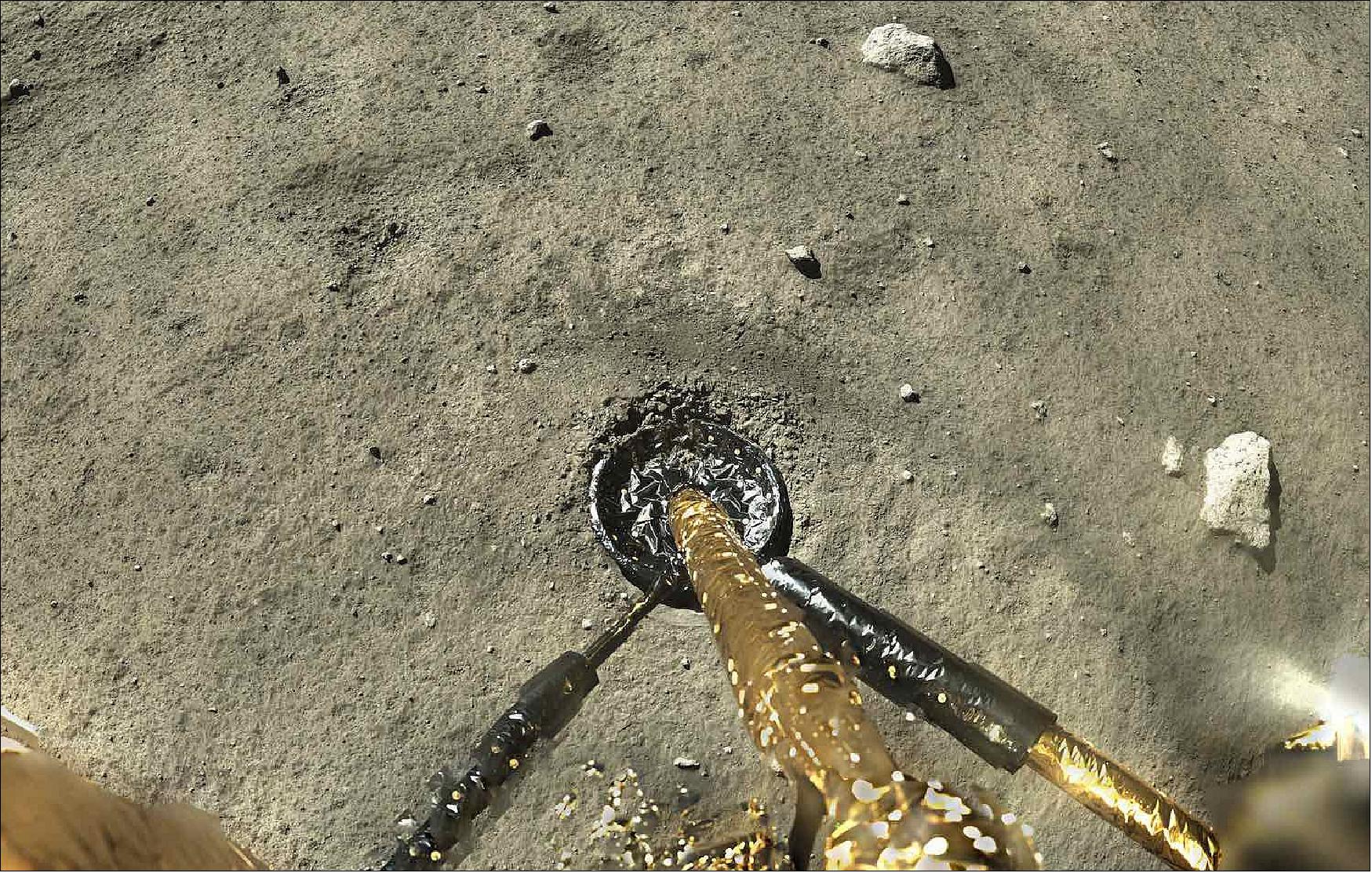
- Chinese officials said the Chang’e-5 mission finished drilling and scooping samples from a lunar lava plain late Wednesday, hours before the spacecraft’s robotic ascender was due to take off from the moon to begin the trip back to Earth.
- The milestone signaled the start of the mission’s return voyage, which includes an ambitious series of automated maneuvers to blast off from the lunar surface Thursday and rendezvous with an orbiter circling the moon. Chang’e-5 will attempt the first-ever docking between two robotic spacecraft in lunar orbit, then transfer the moon rock container into the return craft.
- If all goes according to plan, Chang’e 5’s sample container should re-enter Earth’s atmosphere and parachute to a landing in China’s Inner Mongolia region around Dec. 16.
- Chang’e-5 completed its sample collection work on the moon around 9:00 a.m. EST (14:00 GMT) Wednesday, according to the China National Space Administration.
- The lander touched down at 10:11 a.m. EST (15:11 GMT) Tuesday in the moon’s Oceanus Procellarum, or Ocean of Storms, region in the northern hemisphere of the near side of the moon, east of a volcanic plateau named Mons Rümker.
- CNSA said the lander deployed solar panels and a communications antenna after landing, then activated a panoramic camera, an instrument to analyze lunar soil structure, and a mineral spectrum analyzer to survey the alien landscape surrounding the spacecraft.
- Data from the science instruments will provide a reference for scientists as they study the samples brought back by Chang’e-5, CNSA said in a statement.
- The Chang’e-5 spacecraft completed the first phase of sample collection operations at 3:53 p.m. EST (20:53 GMT) Tuesday, when officials said the lander finished drilling underground rock specimens and sealed the material inside a return carrier.
- The next step in the mission’s two-day lunar stay involved using a scoop at the end of a robotic arm to gather material from the lunar surface. CNSA said the 19-hour sampling activity ended late Wednesday, Beijing time.
- The spacecraft packaged and sealed the lunar material in a storage device carried by the Chang’e-5 ascender, which is scheduled to take off from the moon Thursday, using the mission’s descent stage as a launch pad.
- The Chang’e-5 mission’s goal was to collect ~2 kg of rocks for return to Earth. Chinese officials have not released an estimate of how much material the spacecraft gathered on the moon.
- The successful landing of Chang’e-5 on Tuesday marked the third time China has soft-landed a spacecraft on the moon, following the Chang’e-3 mission in 2013 and Chang’e-4 in 2019. Chang’e-4 became the first spacecraft to achieve a soft landing on the far side of the moon, a feat enabled by the placement of a purpose-built Chinese data relay satellite in deep space.
- Chang’e-3 and Chang’e-4 carried rovers to serve as mobile scouts exploring the lunar landscape. Chang’e-5’s mission on the lunar surface has no mobile rover, and the craft is designed to complete its work in two days while in sunlight, rather than surviving the two-week super-cold lunar night.
- Clive Neal, a lunar scientist at the University of Notre Dame, said China had proven it can land on the moon with previous missions.
- “But then they have to collect the sample,” Neal said in an interview shortly after Chang’e-5’s launch. “The interesting thing is they launch from the moon, get into lunar orbit, and then rendezvous with the Earth re-entry vehicle that will bring that sample back to Earth safely and uncompromised. When the Soviets did it in 1976, the last time, it was direct to Earth. They launched from the moon and came straight back to Earth. This one has an extra step in there, which has to go well in order for the sample to actually make it back.
- “But given the capability they’ve demonstrated with doing things for the first time, such as the far side landing and roving, I expect things to be successful, and hope they are,” Neal said in an interview with Spaceflight Now.
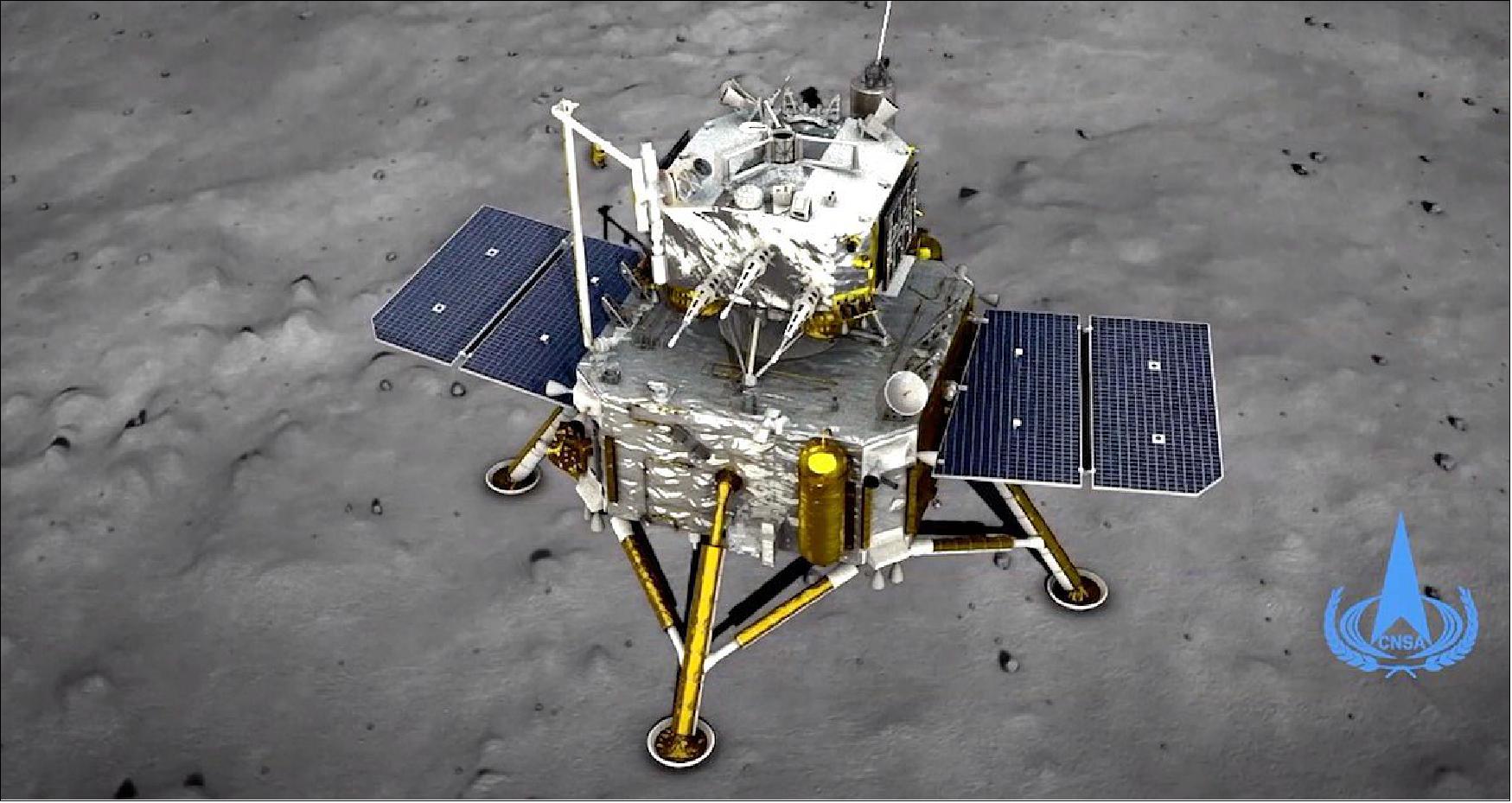
- “We have never done a whole process of taking and sealing samples,” said Peng Jing, deputy chief designer of the Chang’e-5 mission at the China Academy of Space Technology, in an interview aired on China’s state-run CCTV television channel. “This part of the work mainly depends on several complicated structures including the drill ... the robotic arms used to scoop up rocks and regolith on the lunar surface, and actually a high vacuum sealing device designed to ensure that the sample can remain in its intact status.”
- Scientists want to make sure the lunar specimens are sealed for the return to Earth to avoid contamination.
- Another challenge will be Chang’e-5’s launch from the lunar surface, the first takeoff from the moon since the 1970s. The ascent module must launch on a precise trajectory to rendezvous with the return module in lunar orbit, and ground teams did not know the lander’s exact orientation on the moon’s surface until after touchdown.
- “We need to precisely anticipate the location and speed of the two spacecraft flying (in) lunar orbit,” Peng told CCTV. “Because the probes don’t match in size — our ascender weighs just around 300 to 400 kg during docking, while the (orbiter) weighs nearly 2,000 kg. Any error could knock off the smaller spacecraft, and that would make the docking job much more difficult than before.”
- After transferring the samples to the Earth return spacecraft, Chang’e-5 will fire engines to break out of lunar orbit and head for home.
- The return carrier will re-enter the atmosphere at some 40,000 km/hr, significantly faster than a re-enter from low Earth orbit.
- Nine missions have returned moon samples to Earth, including NASA’s six Apollo missions with astronauts, and three robotic Luna spacecraft launched by the Soviet Union. NASA’s Apollo missions brought back 382 kg of rocks from the moon.
- There is evidence that rocks in Chang’e-5’s landing zone are much younger than those returned by the Apollo astronauts. Those specimens are some 3.5 billion years old, created during a period of active volcanism in the first billion years of the moon’s existence.
- Lava plains to the east of Mons Rümker appear to be less battered by asteroid impacts, suggesting rocks there could be less than 2 billion years old. But models of the moon’s evolution suggest its internal heating should have diminished by that time, rendering volcanoes extinct, Neal said.
- “It will be exciting to look at the age of these samples coming back and also the actual compositions of them,” Neal said.
- “We haven’t returned samples form the moon in 44 years, since Luna 24, a long time ago,” said James Head, a planetary scientist at Brown University, in an interview broadcast on China’s CGTN television network. “The best way to learn about the moon is by returning samples. That’s true for any planetary body because we can do analyses in the lab that are far superior than what we can do remotely or in situ.”
- ”Chinese scientists have said that samples from different ages are needed to form a complete picture of the moon,” Peng said. “Through analysis, they think the samples we will collect from the northwest region of Oceanus Procellarum are relatively young. By combining those samples with the previous ones, we will have a better understanding of the moon’s formation and evolution.”
• December 1, 2020: China’s Chang’e-5 has successfully landed on the moon in a major step towards obtaining the youngest lunar samples so far collected and delivering them to Earth. 25)
- The Chang’e-5 lander initiated a powered descent at 9:58 a.m. EST (Eastern Standard Time) and successfully completed its soft landing near Mons Rümker in Oceanus Procellarum (“Ocean of Storms”) at 10:11 a.m. EST (15:11GMT, 23:11 Beijing Time).
- The lander will within a few hours begin collecting samples by drilling up to two meters into the lunar regolith, with a scoop to later take material from the surface. Liftoff of a small spacecraft atop the lander will take place in around 48 hours.
- A waiting lunar orbiter will collect the samples from the ascent vehicle and deliver them to Earth around December 16.
- The mission is the first lunar sample return attempt since the end of the U.S. Apollo and Soviet Luna missions in the 1970s. It is hoped the radiometric dating of samples brought to Earth will confirm the age of rock units theorized geologically youthful.
- A relative lack of crater impacts observed in parts of this western edge of the moon suggest that it contains basaltic rocks created by late-stage volcanism which could be billions of years younger than those collected from Apollo and Soviet Luna landing sites.
- “With the new age data, we can calibrate the crater counting method, being more precise for young events,” Dr. Lin Yangting, at the Institute of Geology and Geophysics in Beijing under the Chinese Academy of Sciences, told SpaceNews. Additionally, scientists will conduct compositional, mineralogical and radioisotope analysis to ascertain “the nature of the young basalt and its mantle reservoir, in order to understand why the basalt erupted so [much] later.”
- Thomas Zurbuchen, NASA associate administrator for science, tweeted his congratulations shortly after landing and expressed hopes that the samples could advance the international science community.
- The four-module Chang’e-5 spacecraft launched on a Long March 5 rocket Nov. 23. It then embarked on a 112-hour to the moon and entered lunar orbit Nov. 28 before the spacecraft separated in preparation for the landing attempt.
- The lander is carrying science, imaging and sampling equipment along with the small ascent vehicle designed to lift samples back into lunar orbit. An orbiting service module remains in a lunar orbit ready to receive the samples, a process requiring an exacting and time-critical automated rendezvous and docking with the ascent vehicle.
- Tuesday’s lunar landing is China’s third, following the Chang’e-3 and Chang’e-4 missions which touched down in 2013 and 2019 respectively. Chang’e-4 also made the first ever landing on the lunar far side with the aid of a relay satellite positioned beyond the moon.

Next Steps
- Now on the surface, the Chang’e-5 lander has 48 hours to carry out its science and sampling activities and prepare the ascent vehicle for liftoff. Twenty hours are set aside for collecting around two kilograms of lunar materials. These will consist of 0.5 kg samples from drilling and 1.5 kg scooped from the surface and placed in a container aboard the ascent vehicle.
- Then follows perhaps the most challenging stages of the complex Chang’e-5 mission. The roughly 500 kg ascent vehicle will launch from atop the lander into a 15 by 185-kilometer orbit to meet up with the waiting service module, which is meanwhile performing phasing burns in lunar orbit. Around two days after ascent vehicle liftoff the two spacecraft will have a 3.5-hour window during which they must perform rendezvous and docking.
- China has conducted rendezvous and docking operations, both automated and manually, in low Earth orbit using Shenzhou crewed spacecraft, Tiangong space labs and Tianzhou cargo vessels. This operation will however be taking place nearly 400,000 km from Earth, bringing not insignificant light-time delay. It would also be the first ever robotic docking operation in lunar orbit.
- After a successful docking the sample canister will be transferred from ascent vehicle to the reentry module attached to the service module. The ascent vehicle will then be jettisoned. The service module will spend 6-7 days in lunar orbit awaiting the optimal Earth return trajectory window for a reentry and landing at Siziwang Banner, Inner Mongolia 112 hours later.
- The reentry vehicle will separate from the service module around 5,000 km from Earth. A skip reentry, involving bouncing off the atmosphere — a maneuver tested by the Chang’e-5 T1 mission in 2014 — to deal with the high-velocity return from the moon will follow. ESA tracking stations will support this critical phase as the spacecraft attempts reentry.
- Samples will then be transferred to specially constructed facilities in Beijing and Hunan for handling, analyzing and storing the lunar material.
• November 25, 2020: The Chang'e-5 lunar mission will need to overcome a succession of challenges and difficulties before it can be declared a complete success, project insiders said. 26)
- Mission spokesman Zhaoyu Pei said Chang'e-5 will be the first Chinese spacecraft to carry out sample collection and launch operations on an extraterrestrial body, and these maneuvers will be extremely demanding and sophisticated in terms of technology and engineering complexity.
- After the samples are collected and packed into the ascender, it will need to be lifted into lunar orbit to rendezvous and dock with the combined orbiter and reentry capsule in an exceptionally accurate, delicate manner. Otherwise, it will be damaged and fail to deliver the samples, he added.
- Even at the very beginning of the mission, Chang'e-5 had to go through some new operations, said Pei, who is deputy director of the China National Space Administration's Lunar Exploration and Space Program Center. He explained that it was the first Chinese lunar mission to use the Long March 5 heavy-lift carrier rocket and the Wenchang Space Launch Center in Hainan province. All the previous Chang'e programs were carried on Long March 3 rockets launched from the Xichang Satellite Launch Center in Sichuan province.
- Dengyun Yu, deputy chief designer of China's lunar exploration program, said: "First of all, Chang'e-5's most important task will be collecting lunar samples. The environment on the lunar surface, such as the gravity there, is very different from that on Earth. So we must ensure that our technologies are functional and reliable during the collection and packing processes.
- "The next challenge will be lifting the sample-carrying ascender from the moon. All of our launches so far were made from Earth, but the coming launch will take place on lunar soil and use the Chang'e-5's lander as the launchpad. Consequently, the challenge will be whether our equipment can handle the complicated operation as it was designed to do."
- Previous rendezvous and docking by Chinese spacecraft occurred in low-Earth orbit-hundreds of kilometers above the planet-but this time it will take place in lunar orbit nearly 380,000 km away, Yu said.
- The last challenge, he said, will emerge during the re-entry process as the re-entry capsule will descend through Earth's atmosphere at a speed of 11.2 km/s, much faster than almost all previous Chinese spacecraft.
- "The ultrafast speed will verify the aerodynamic design, heat-resistant materials and flight control system on the re-entry module," Yu said.
• November 25, 2020: Space experts and educators from around the world are closely following the Chang'e-5 mission and are optimistic it can achieve its targets. Professor Martin Sweeting, a fellow of the Royal Society of the United Kingdom and a distinguished professor of space engineering at the University of Surrey, said the international science community has been looking forward to the mission and the first collection of lunar samples since 1976. 27)
- He said following China's extremely successful Chang'e-4 mission to the moon's far side, lunar samples collected by Chang'e-5 will make "further important contributions" to global knowledge of the composition of previously unexplored near-side regions.
- "This mission is particularly relevant considering the renewed interest in the moon following the discovery of water trapped in cold locations of the surface and intensive international preparations for humans to return to the moon," Sweeting said. "China's contribution to this international effort will be very important, much welcomed and greatly valued."
- Bonnie Thurber from the SpacEdge Academy, an educational program under the United States' National Space Society, said: "I am very excited about Chang'e-5. I hope everything goes as planned. It is very important to me that all space scientists share and build on information, because the more we know about the moon and space, the sooner we will be able to set up outposts and move forward. I am very hopeful that China will share the information it collects with the rest of the world's space science programs so we can all grow from this mission."
- Alan Gould, emeritus director of the Lawrence Hall of Science Planetarium at the University of California, Berkeley, said the mission is expected to make significant contributions to long-term lunar research goals. Gould said as Chang'e-5 will be collecting surface samples younger than those brought back last century by the Apollo missions, he expects to see advances in knowledge of the composition of lunar materials.
- "Even more exciting is the longer-term goal to establish an international lunar research station," he said, adding he wished the Chang'e-5 team the best of luck. He also expressed hope for more cooperation between the US and China in space exploration.
- Steve Durst, founding director of the International Lunar Observatory Association, a nonprofit organization in Hawaii, described the Chang'e-5 mission as "historic, revolutionary and pioneering".
- "The International Lunar Observatory Association has always considered Chang'e-5 as the decisive gateway mission to enable commitment and preparation for China's astronauts to travel to and land on the moon," Durst said.
- He said the opportunities and advancements resulting from China's lunar exploration program have been enormous for science, technology, education and business. International collaboration on the basis of equality and mutual benefit will also be fostered, as well as peaceful and productive uses of the moon for the entire humanity.
- "I hope the revolutionary Chang'e 5 mission will carry and advance a most important accomplishment of the US Apollo moon landings, as inscribed on the plaque Neil Armstrong and Buzz Aldrin placed on the moon-'We came in peace for all mankind'."
- Oded Ben-Horin, an associate professor at the Western Norway University of Applied Sciences in Bergen, Norway, said besides scientific and technological achievements, Chang'e-5 will also act as an inspiration for creative education. He hopes educators around the world will study the findings of the mission and share them with students.
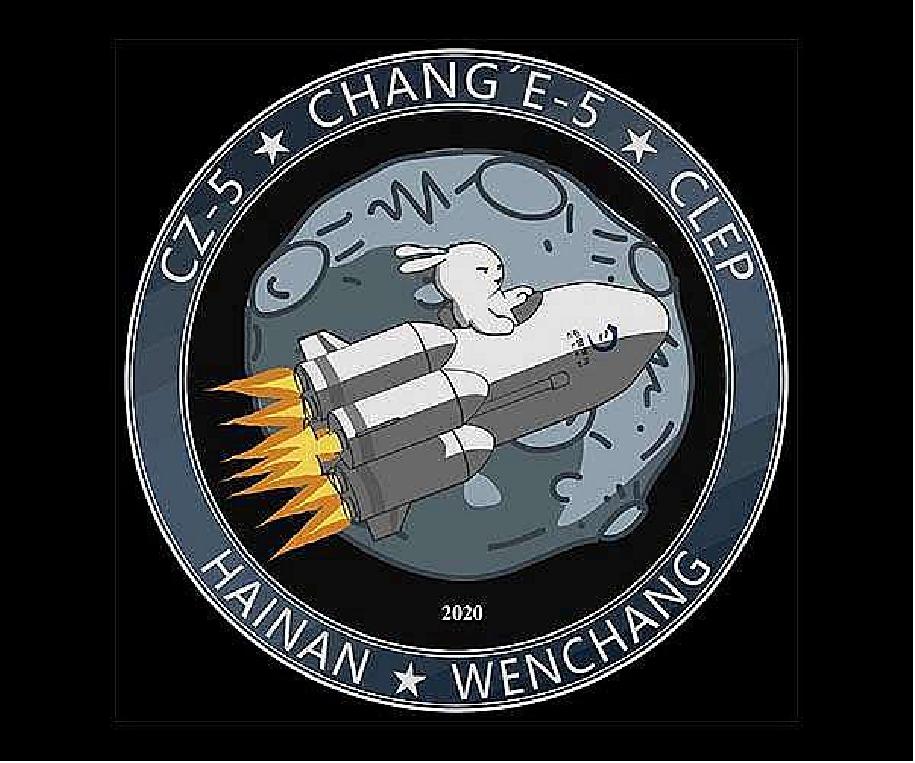
References
1) ”China schedules Chang'e-5 lunar probe launch,” Xinhua, January 22, 2017, URL: http://news.xinhuanet.com/english/2017-01/22/c_136004958.htm
2) Andrew Jones, ”China is quietly preparing for November launch of the Chang’e-5 lunar sample return mission,” Space News, 17 September 2020, URL: https://spacenews.com/
china-is-quietly-preparing-for-november-launch-of-the-change-5-lunar-sample-return-mission/
3) ”Chang’e-5 Spacecraft Overview,” Spaceflight101, URL: https://spaceflight101.com/change/change-5/
4) ”China launches Moon probe to bring back lunar rocks,” Moon Daily, 23 November 2020, URL: https://www.moondaily.com/reports/China_launches_Moon_probe_to_bring_back_lunar_rocks_999.html
5) ”China's space tracking ship sails for Chang'e 5 mission,” Space Daily, 20, November 2020, URL: https://www.spacedaily.com/reports/Chinas_space_tracking_ship_sails_for_Change_5_mission_999.html
6) ”ESA tracks Chang'e-5 Moon mission,” ESA Enabling & Support, 18 November 2020, URL: https://www.esa.int/ESA_Multimedia/Images/2020/11/ESA_tracks_Chang_e-5_Moon_mission
7) ”Rocket to lift Chang'e 5 moved to launch pad,” Moon Daily, 17 November 2020, URL: https://www.moondaily.com/reports/Rocket_to_lift_Change_5_moved_to_launch_pad_999.html
8) Stephen Clark, ”China set to attempt first lunar sample return mission in four decades,” Spaceflight Now, 22 November 2020, URL: https://spaceflightnow.com/2020/11/22/
china-set-to-attempt-first-lunar-sample-return-mission-in-four-decades/
9) Andrew Jones, ”China launches Chang’e-5 Moon sample return mission,” SpaceNews, 23 November 2020, URL: https://spacenews.com/china-launches-change-5-moon-sample-return-mission/
10) Andrew Jones, ”A Chinese spacecraft is testing out a new orbit around the moon,” SpaceNews, 15 February 2022, URL: https://spacenews.com/
a-chinese-spacecraft-is-testing-out-a-new-orbit-around-the-moon/
11) ”Chang'E-5 Lander Makes First Onsite Detection of Water on Moon,” Moon Daily, 12 January 2022, URL: https://www.moondaily.com/reports/
ChangE_5_Lander_Makes_First_Onsite_Detection_of_Water_on_Moon_999.html
12) Honglei Lin, Shuai Li, Rui Xu, Yang Liu, Xing Wu, Wei Yang, Yong Wei , Yangting Lin, Zhiping He, Chi Wang, ”In situ detection of water on the Moon by the Chang’E-5 lander,” Science Advances, Vol. 8, Issue 1, 7 January 2022, https://www.science.org/doi/10.1126/sciadv.abl9174
13) ”China's Chang'e-5 mission offers new insights into evolution of Moon,” Moon Daily, 21 October 2021, URL: https://www.moondaily.com/reports/
Chinas_Change_5_mission_offers_new_insights_into_evolution_of_Moon_999.html
14) Qiu-Li Li, Qin Zhou, Yu Liu, Zhiyong Xiao, Yangting Lin, Jin-Hua Li, Hong-Xia Ma, Guo-Qiang Tang, Shun Gao, Xu Tang, Jiang-Yan Yuan, Jiao Li, Fu-Yuan Wu, Ziyuan Ouyang, Chunlai Li, Xian-Hua Li, ”Two billion-year-old volcanism on the Moon from Chang’E-5 basalts,” Nature, Published online: 19 October 2021, https://doi.org/10.1038/s41586-021-04100-2
15) ”China releases lunar sample data online,” Moon Daily, 15 April 2021, URL: https://www.moondaily.com/reports/China_releases_lunar_sample_data_online_999.html
16) Andrew Jones, ”Chang’e-5 orbiter reaches Lagrange point on extended mission,” SpaceNews, 19 March 2021, URL: https://spacenews.com/change-5-orbiter-reaches-lagrange-point-on-extended-mission/
17) ”China's space achievements out of this world,” Space Daily, 1 January 2021, URL: https://www.spacedaily.com/reports/Chinas_space_achievements_out_of_this_world_999.html
18) ”Scientists review how they study lunar samples,” Moon Daily, 1 January 2021, URL: https://www.moondaily.com/reports/Scientists_review_how_they_study_lunar_samples_999.html
19) ”Mission accomplished, now on to the next: China Daily editorial,” Space Daily, 21 December 2020, URL: https://www.spacedaily.com/reports/
Mission_accomplished_now_on_to_the_next_China_Daily_editorial_999.html
20) ”Lunar rocks, soil brought back by Chang'e-5 handed over to scientists,” Space Daily, 21 December 2020, URL: https://www.moondaily.com/reports/
Lunar_rocks_soil_brought_back_by_Change_5_handed_over_to_scientists_999.html
21) Stephen Clark, ”Chinese sample return capsule lands on Earth after round-trip flight to moon,” Spaceflight Now, 16 December 2020, URL: https://spaceflightnow.com/2020/12/
16/chinese-sample-return-capsule-lands-on-earth-after-round-trip-flight-to-moon/
22) ”Chang'e 5 in moon-to-Earth trajectory,” Moon Daily, 14 December 2020, URL: https://www.moondaily.com/reports/Change_5_in_moon_to_Earth_trajectory_999.html
23) Steven Clark, ”Chinese mission accomplishes first-ever robotic docking in lunar orbit,” Spaceflight Now, 5 December 2020, URL: https://spaceflightnow.com/2020/12/05/
chinese-mission-accomplishes-first-ever-robotic-docking-in-lunar-orbit/
24) Stephen Clark, ”Chinese probe completes sample collection work on lunar surface,” Spaceflight Now, 2 December 2020, URL: https://spaceflightnow.com/2020/12/02/
chinese-probe-completes-sample-collection-work-on-lunar-surface/
25) Andrew Jones, ”Chang’e-5 successfully lands on moon to collect youngest lunar samples,” SpaceNews, 1 December 2020, URL: https://spacenews.com/
change-5-successfully-lands-on-moon-collect-youngest-lunar-samples/
26) ”Moon mission tasked with number of firsts for China,” Space Daily, 25 November 2020, URL: https://www.spacedaily.com/reports/Moon_mission_tasked_with_number_of_firsts_for_China_999.html
27) ”Experts expect major contributions from Chang'e 5 lunar mission,” Moon Daily, 25 November 2020, URL: https://www.moondaily.com/reports/
Experts_expect_major_contributions_from_Change_5_lunar_mission_999.html
The information compiled and edited in this article was provided by Herbert J. Kramer from his documentation of: ”Observation of the Earth and Its Environment: Survey of Missions and Sensors” (Springer Verlag) as well as many other sources after the publication of the 4th edition in 2002. - Comments and corrections to this article are always welcome for further updates (eoportal@symbios.space).